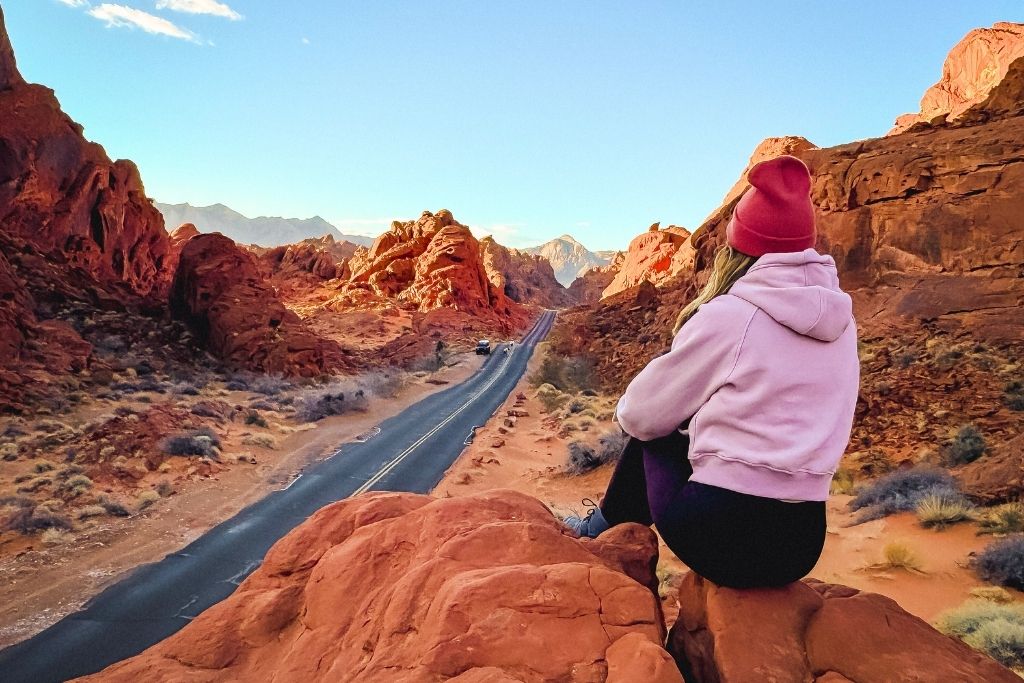15 Unforgettable Things to Do in Valley of Fire State Park
Have you ever stepped into a place so surreal it feels like another planet? That’s exactly how I felt exploring Valley of Fire State Park, a landscape of fiery red rock formations, ancient petroglyphs, and winding slot canyons.
If you’re looking for the absolute best things to do in Valley of Fire, I’ve got you covered!
I spent a full day and a half camping and hiking through every nook and cranny of this small but mighty park, and let me just say—it did not disappoint. Since I was already in Las Vegas for work, I couldn’t resist sneaking away to this hidden gem for a little weekend adventure.
In this post, I’ll share 15 unforgettable experiences you won’t want to miss, plus insider tips to make the most of your trip!
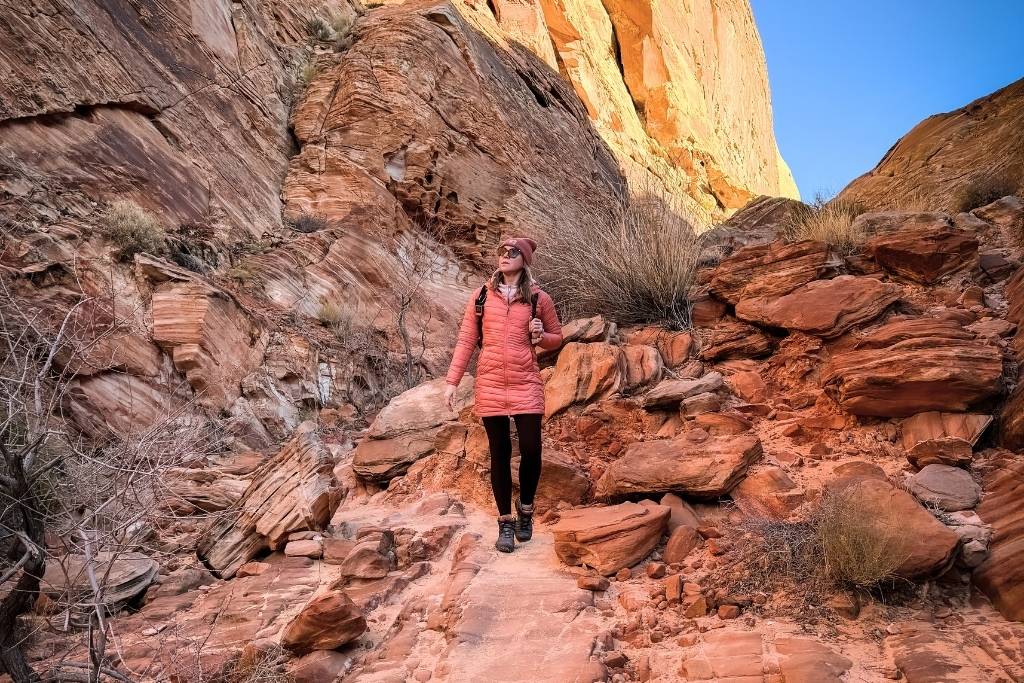

Snapshot of My Top Five Favorite Sights in The Park
White Domes Trail & Slot Canyon
Seven Wonders Loop
Petroglyph Canyon
Rainbow Vista View Point
Mouse’s Tank Road Viewpoint
Top 15 Things to Do in The Valley of Fire
Whether you’re here for epic photography, unique rock formations, or a peaceful desert escape, there’s definitely something here for you. Here are 15 unmissable sights in Valley of Fire that will make your visit one for the books!
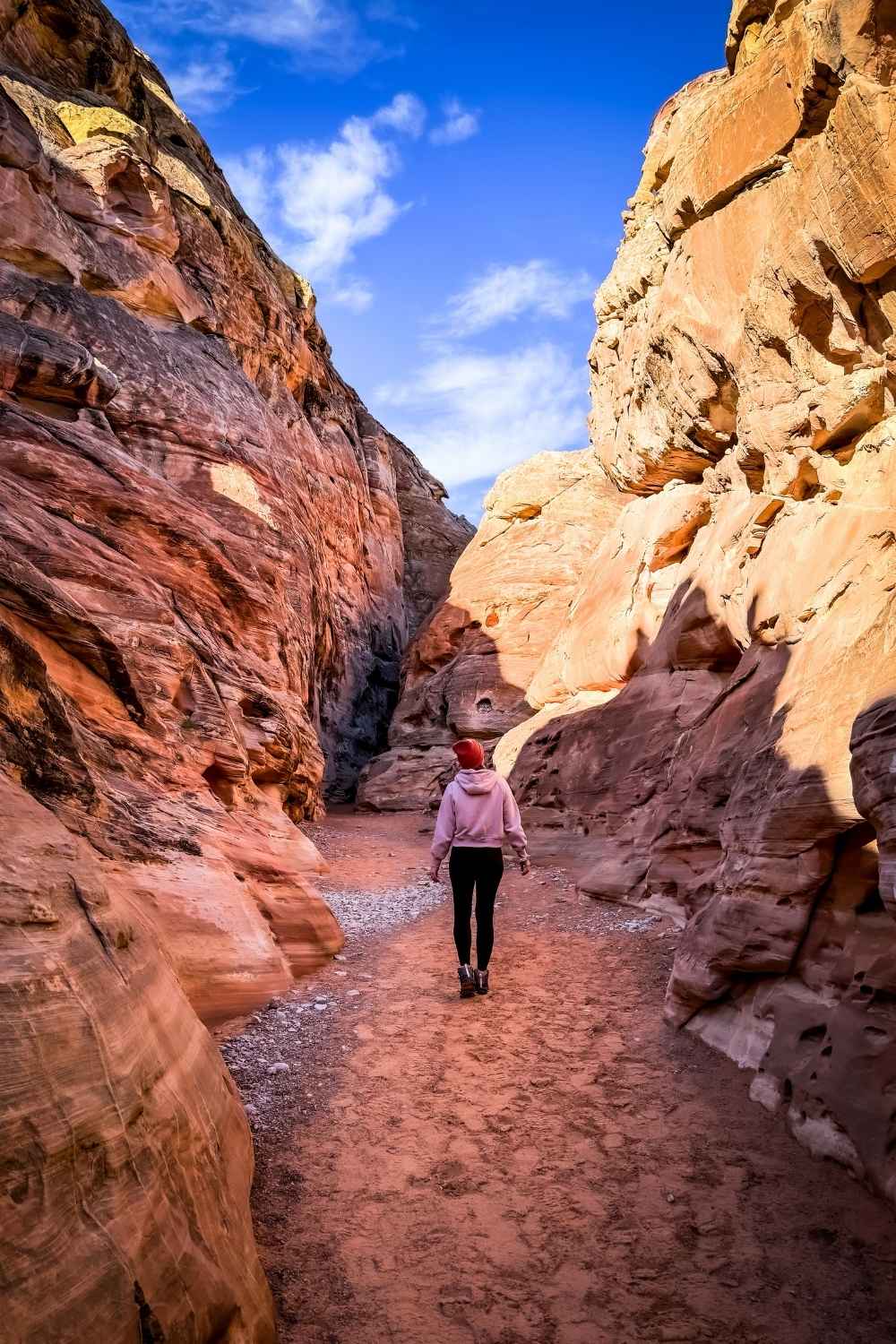
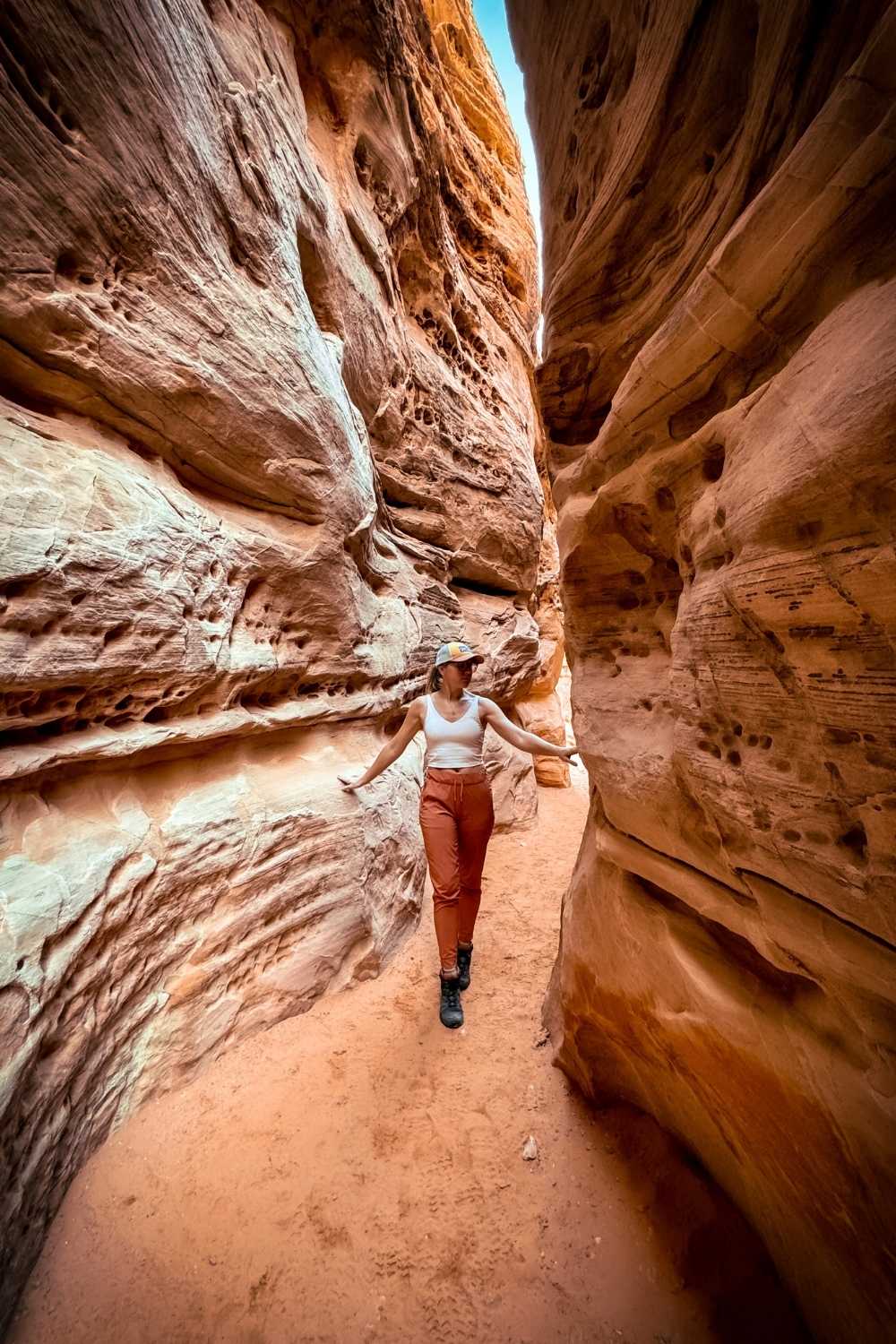
1. Hike White Domes Loop & Slot Canyon
If you only have time for one hike in Valley of Fire, make it this one—it’s one of the best hikes in the park and, hands down, my favorite!
The White Domes Loop may be short, but it packs in jaw-dropping rock formations, a stunning slot canyon, and a sand dune so soft it feels like walking on a beach.
I’m always a sucker for slot canyons, and this trail has a really unique one carved between towering red and pink sandstone walls. To experience it at its best, start this hike first thing in the morning to catch the best lighting and avoid the crowds.
You’ll find the trailhead at the very end of White Domes Road. I recommend hitting this trail first, then working your way back through the park!
Distance: 1.1 miles round trip Difficulty: Easy-Moderate Elevation Gain: 177 feet
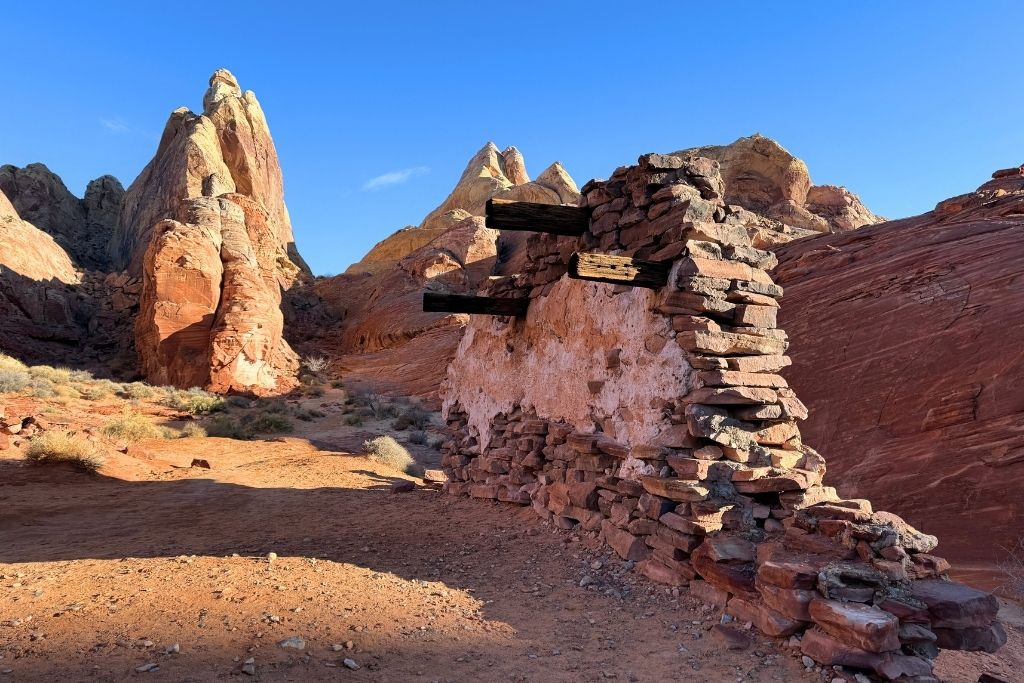
📌 Fun Fact: White Domes was a filming location for a movie called The Professionals. You can still see part of the old movie set built in 1965 along the trail! Other popular movies filmed in the park include “Electric Horseman” and “Star Trek Generations.”
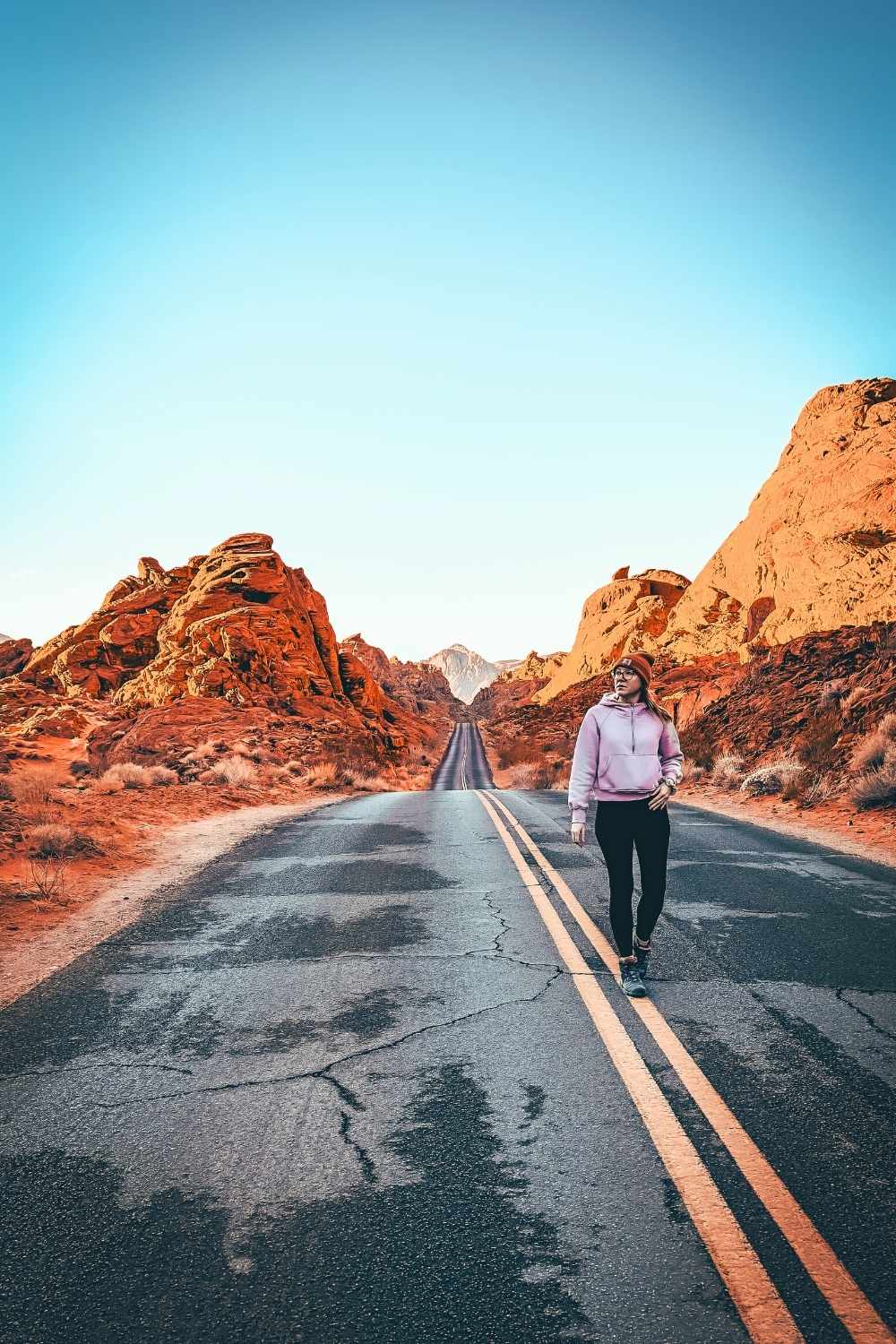
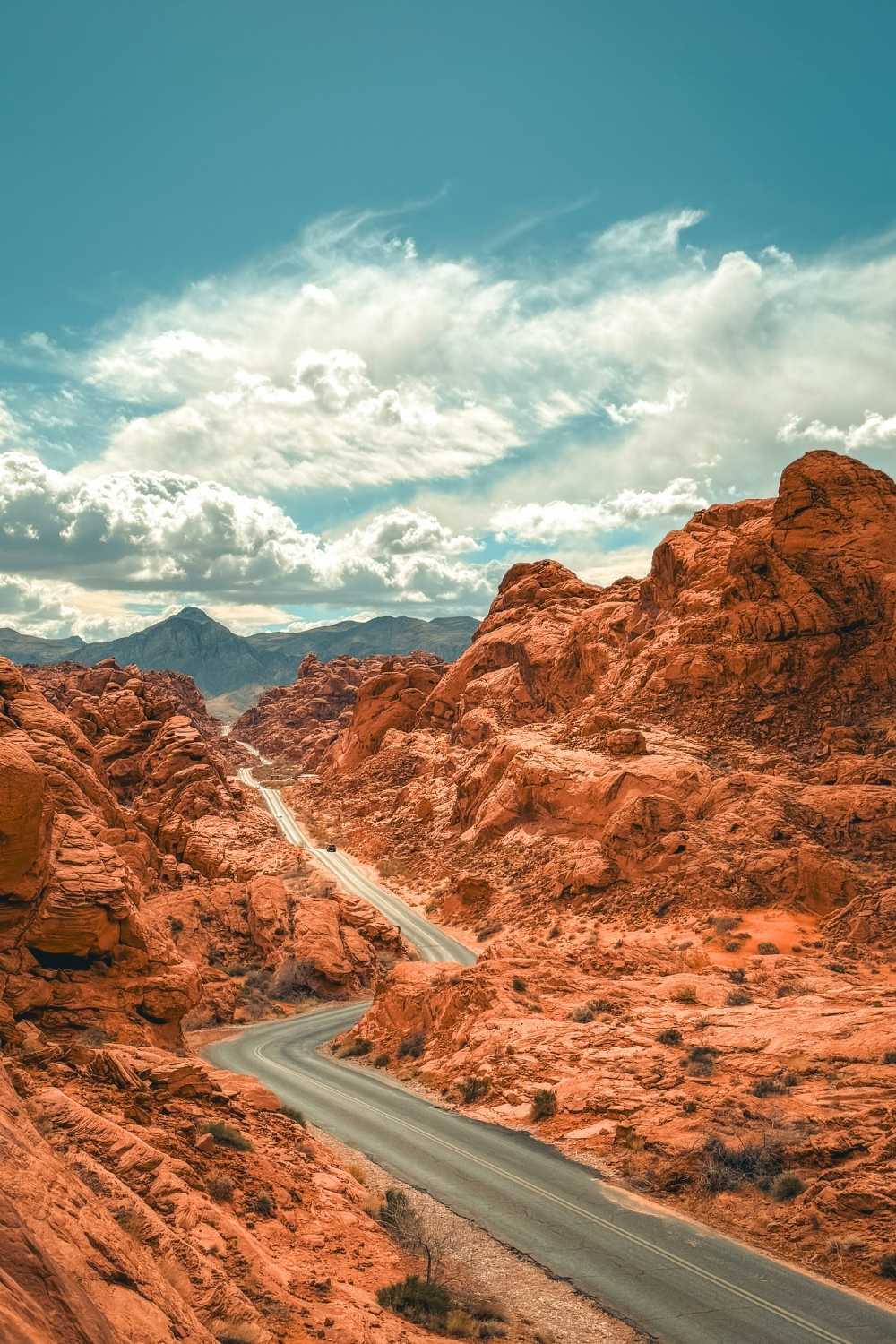
2. Snap an Iconic Photo of Mouse’s Tank Road
If you’ve ever seen a photo of Valley of Fire, chances are it was the shot of Mouse’s Tank Road, winding through towering red rock canyons.
It was this exact image that put Valley of Fire on my bucket list, and waking up early to see it in person before the crowds was worth it!
The contrast of the dark asphalt against the fiery red sandstone makes for one of the most epic road trip shots you’ll ever take.
💡 Pro Tip: This view isn’t at the Mouse’s Tank trailhead parking lot! Instead, park at Rainbow Vista, cross the road, and climb up the rock formations for the best views looking back down the winding road.
3. Drive the Scenic Mouse’s Tank Road
Mouse’s Tank Road is, hands down, the most scenic drive in Valley of Fire, winding through dramatic red rock formations and showcasing some of the park’s best attractions.
This road starts at the Visitor Center and takes you past iconic stops like Rainbow Vista, Fire Wave, White Domes, and Mouse’s Tank itself.
Whether you’re just taking a scenic drive or stopping at every overlook and attraction, this stretch of road is a must for seeing the best of Valley of Fire’s stunning landscapes.
💡 Pro Tip: Tourists and bighorn sheep love this road just as much as drivers do! Often crossing between trails, the sheep tend to wander right onto the pavement, especially near Rainbow Vista. So take it slow, and keep your eyes up.
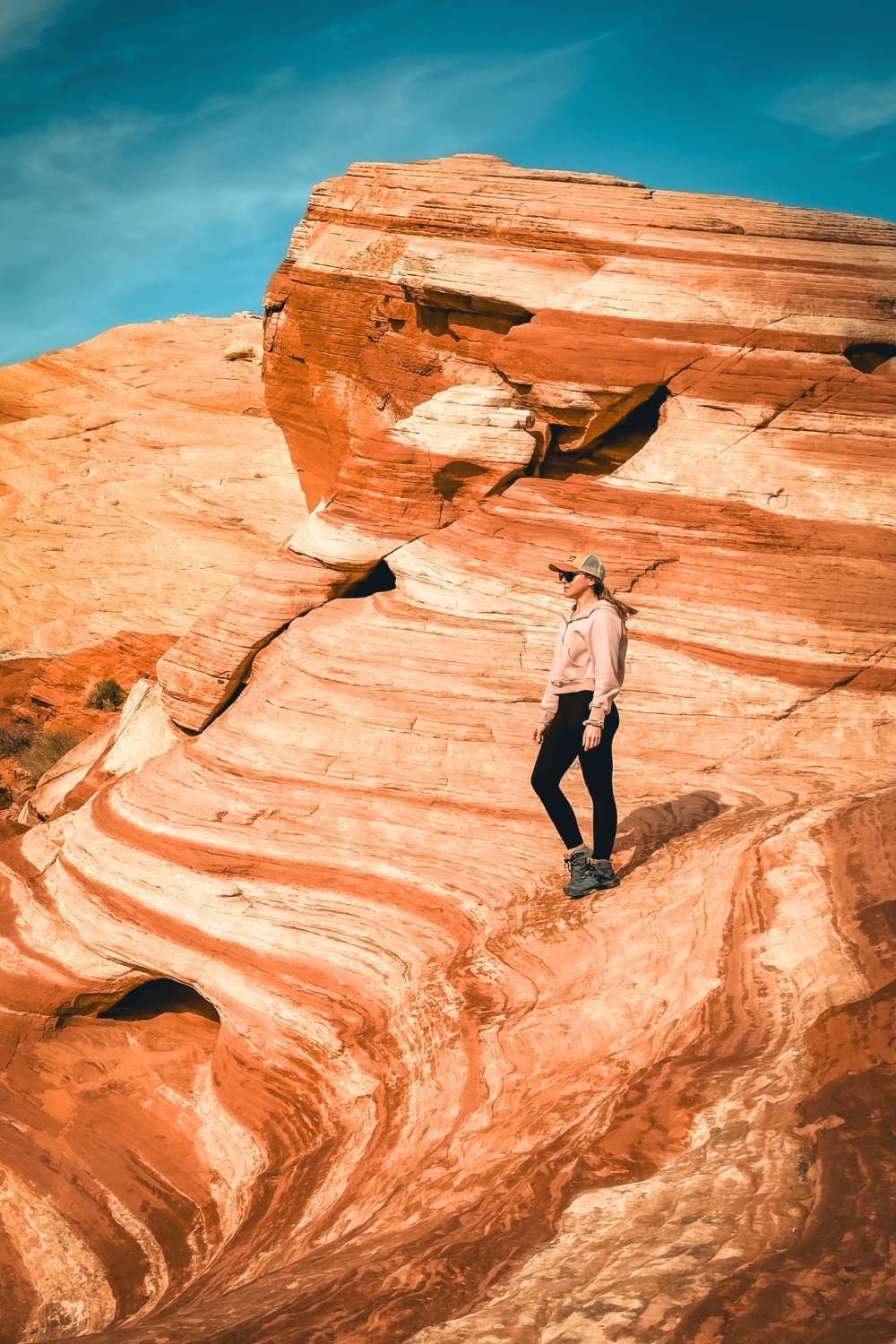
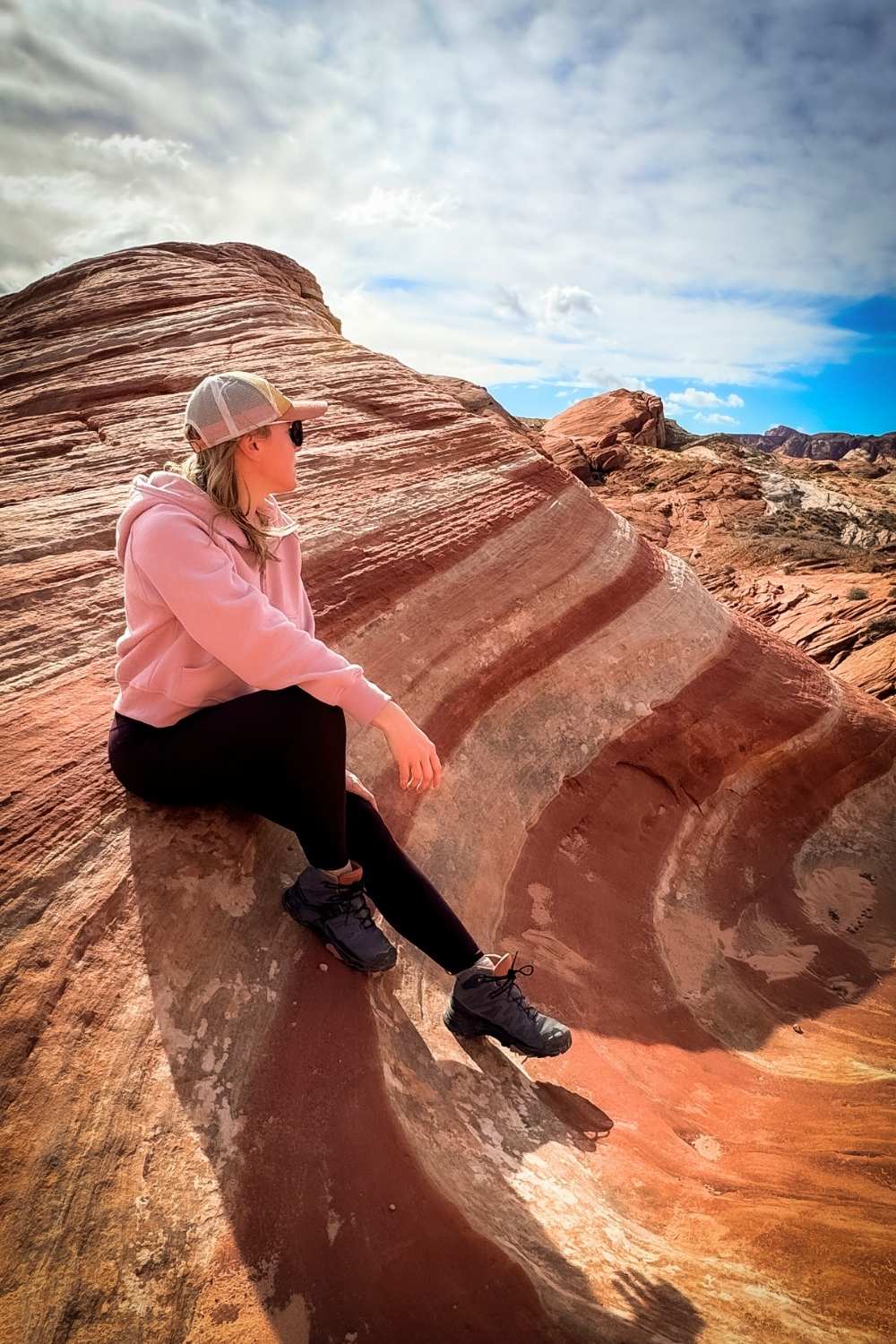
4. Hike to See the Fire Wave
The Fire Wave Trail leads to one of the most photogenic spots in Valley of Fire, where swirling candy cane stripes of red and white sandstone ripple across the desert landscape.
It’s often compared to the famous Wave in Utah, but this one is much smaller and easier to access—no permit required!
The trailhead is at Parking Lot P3 on the park brochure, and you’ll find the path on the right side of the lot, marked by reflector stakes and plenty of footprints in the sand. The 0.8-mile hike (one way) is relatively easy but fully exposed to the sun, so bring water and sun protection.
💡 Pro Tip: This is probably the most popular spot in the park, and getting a photo without people in it can be tricky. Arrive early! I visited in February, and by 10 AM, the parking lot was completely full. If you want the best lighting and fewer crowds, hit the trail right after sunrise!
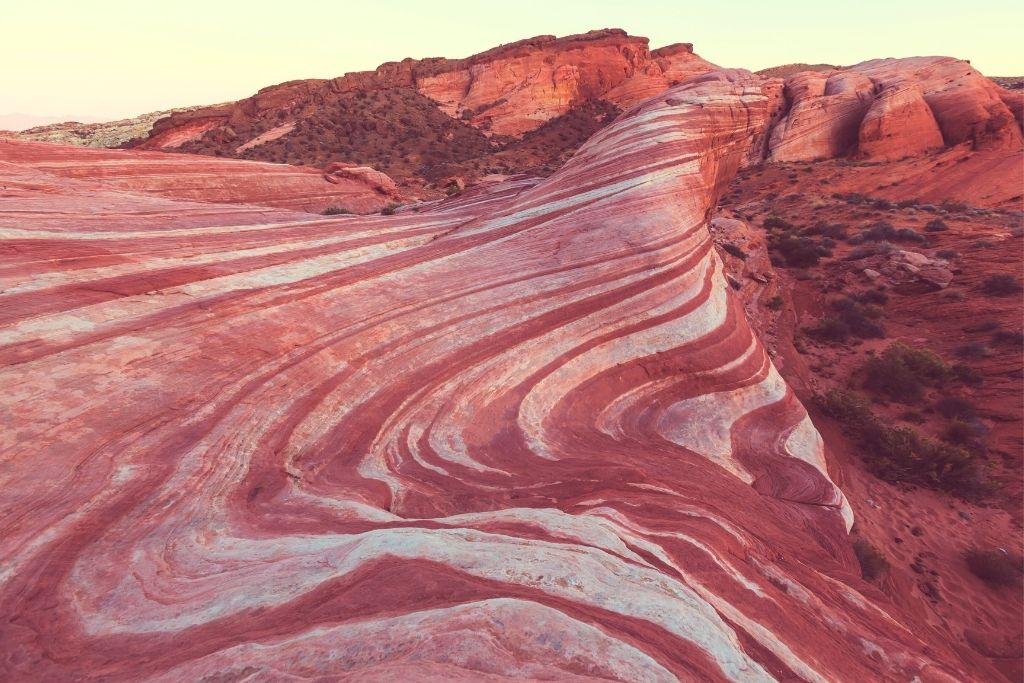
📸 Photography Tip: Climb the small rock outcrop just west of the Fire Wave for an elevated view of the candy cane stripes and the entire desert landscape.
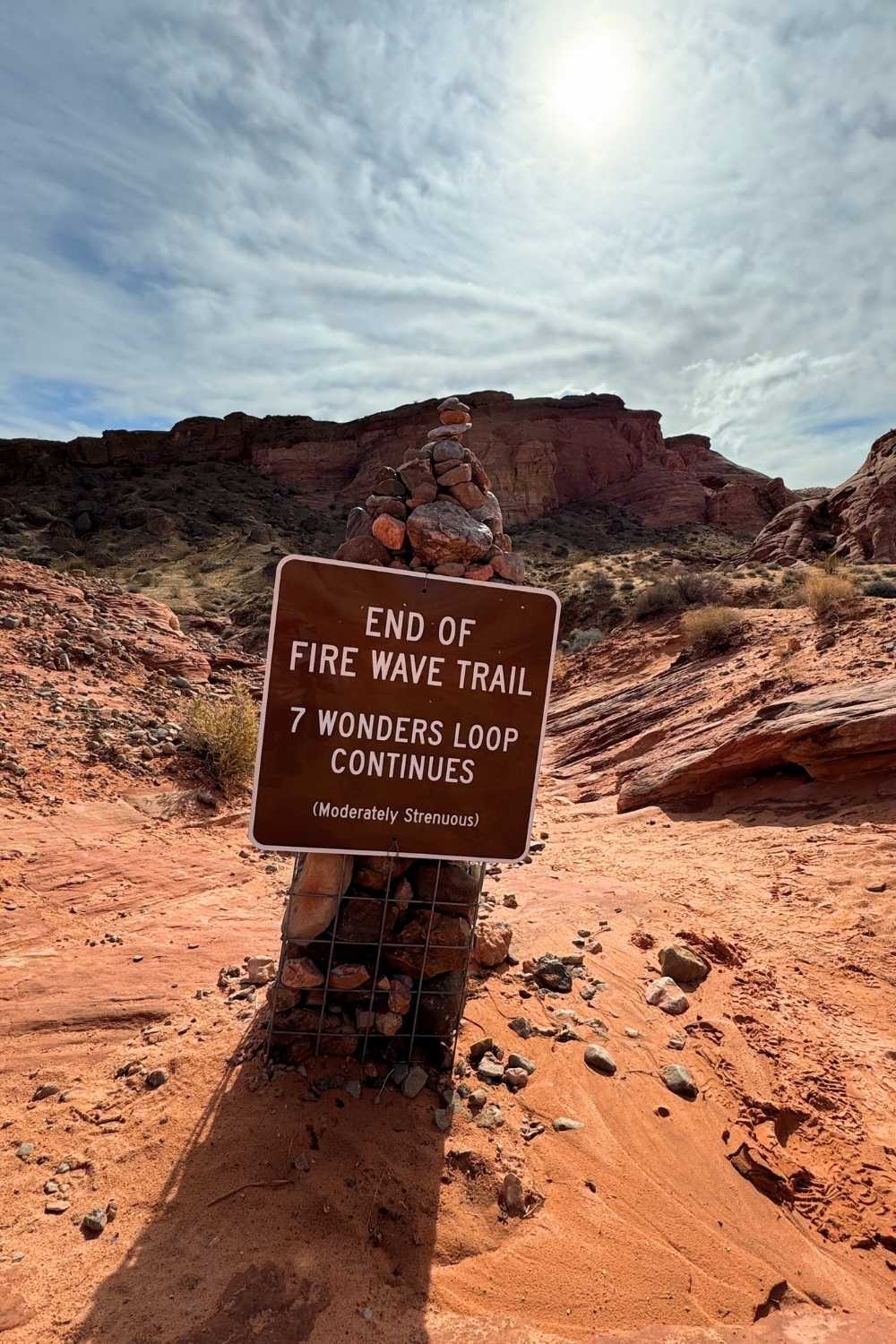
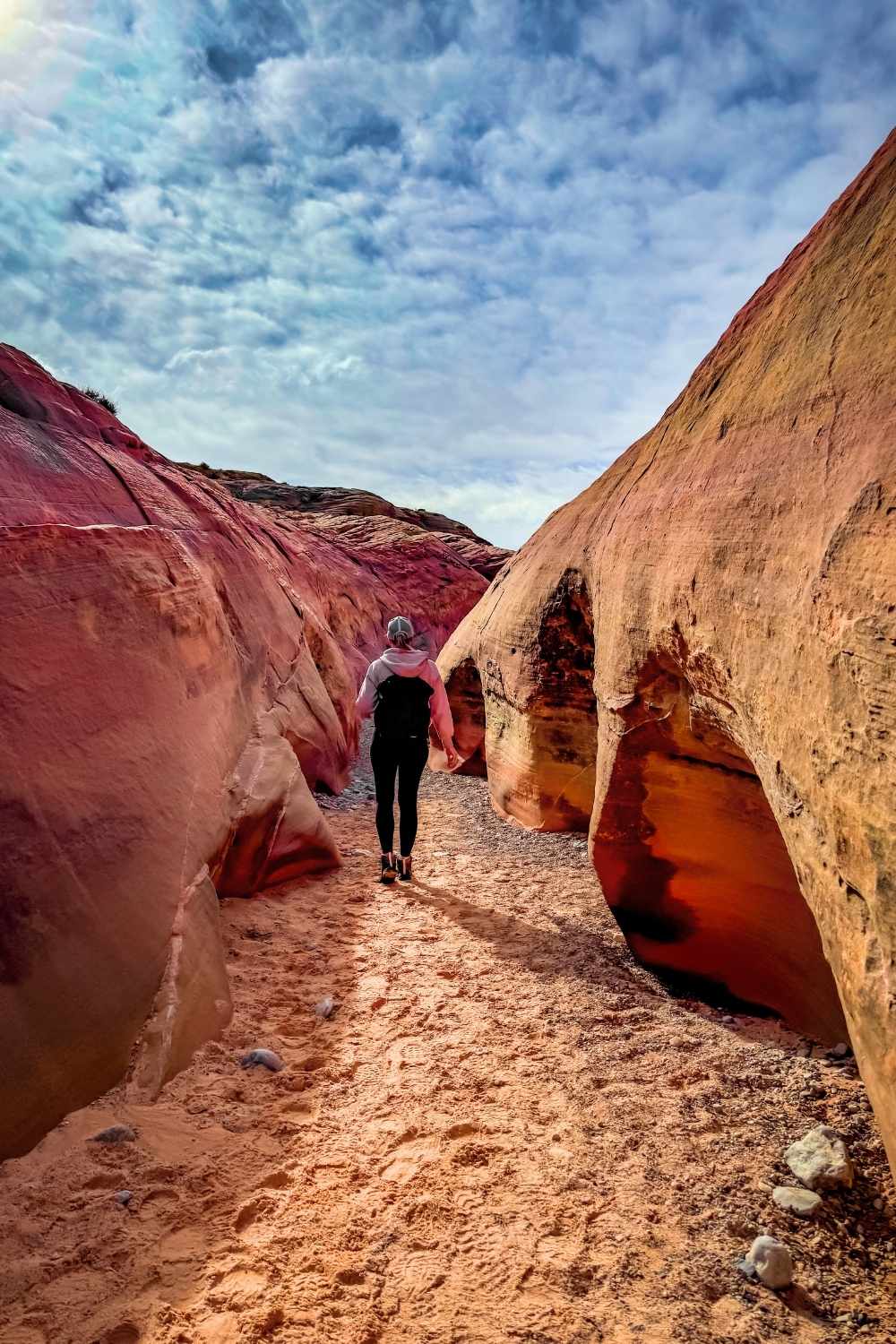
5. Complete the Seven Wonders Loop
If you’re already hiking to the Fire Wave, don’t stop there. Continue onto the Seven Wonders Loop for even more incredible landscapes.
This trail connects several of Valley of Fire’s most unique formations, including the White Domes Slot Canyon, Crazy Hill, Fire Cave, Striped Rock, and Pastel Canyon.
The mix of orange, red, yellow, and pastel pink rock formations makes this one of the most colorful and diverse hikes in the park. Just note that some of the formations take a bit of searching to find. They are not obviously marked or right on the trail.
This was easily one of my favorite trails, and I especially liked crazy hill. I highly recommend it if you want to see more really cool hidden gems beyond the Fire Wave!
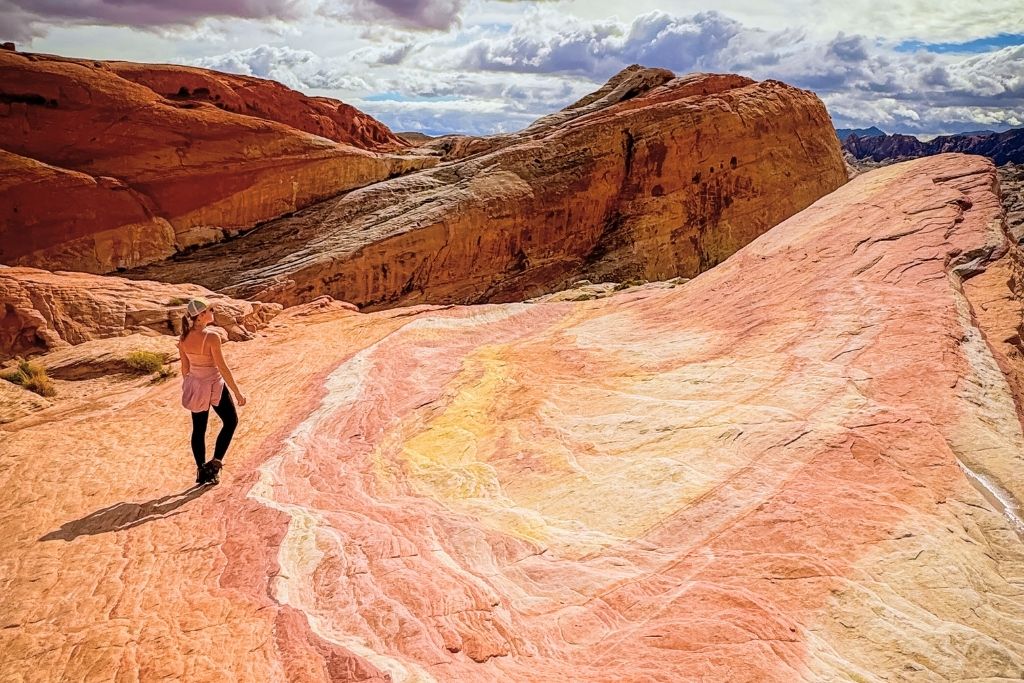
Distance: 1.9 miles Difficulty: Moderate Elevation Gain: 187 feet
💡 Pro Tip: Be sure to download the AllTrails map before you go—there’s no cell service in the park, and this trail isn’t well marked. You’ll end up wandering off the main path a bit, so having the map will make it way easier to find all the cool spots without getting turned lost!
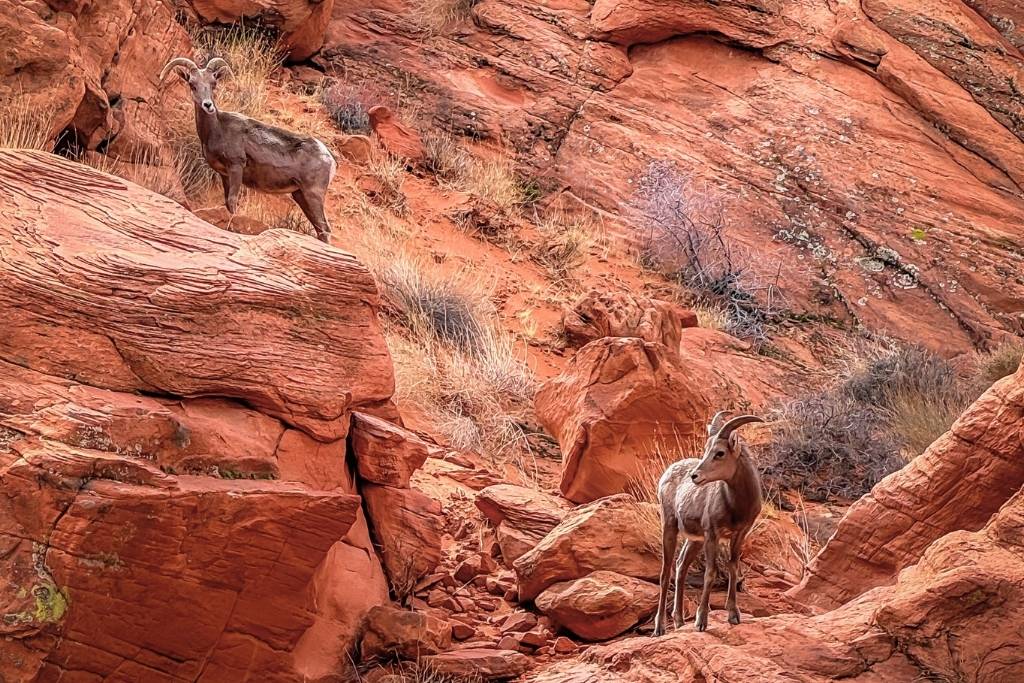
6. Spot Wildlife
One of the coolest surprises in Valley of Fire is how many bighorn sheep there are. Trust me, they’re everywhere if you keep an eye out!
I saw three huge, full-curl rams up at Fire Canyon, Silica Dome Viewpoint, and a lot of females along the Rainbow Vista Trail, but they also like to hang out near Balancing Rock by the Visitor Center.
They may look adorable, but remember, they’re wild animals, not pets—so admire from a distance and do not harass them or try to touch or feed them.

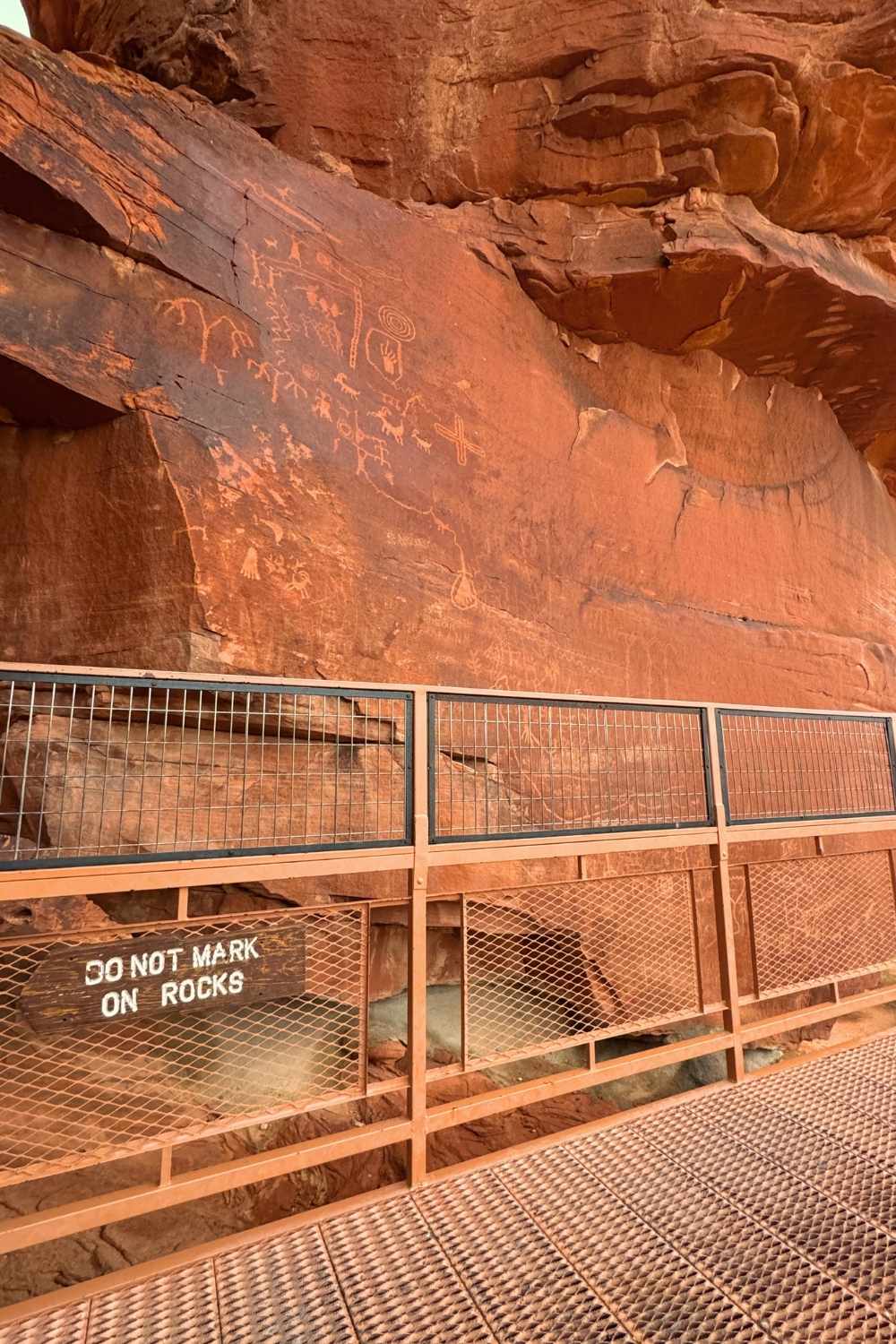
7. Climb Atlatl Rock to see Petroglyphs
Atlatl Rock is a quick but worthwhile stop to see some of the best-preserved petroglyphs in the park.
It’s especially convenient if you’re camping in the park, since it’s just a short walk from both campgrounds. Perfect for an evening visit after a long day of exploring.
A metal staircase leads you up three flights to a rock wall covered in these ancient carvings, depicting animals, symbols, and early life in the region.
It’s a great spot to pause and appreciate the stories left behind by those who lived here thousands of years ago.
📌 Key Point: I saw names and initials carved over these ancient petroglyphs, and it’s heartbreaking. Once they’re damaged, they’re gone forever. Please respect history and leave them untouched!
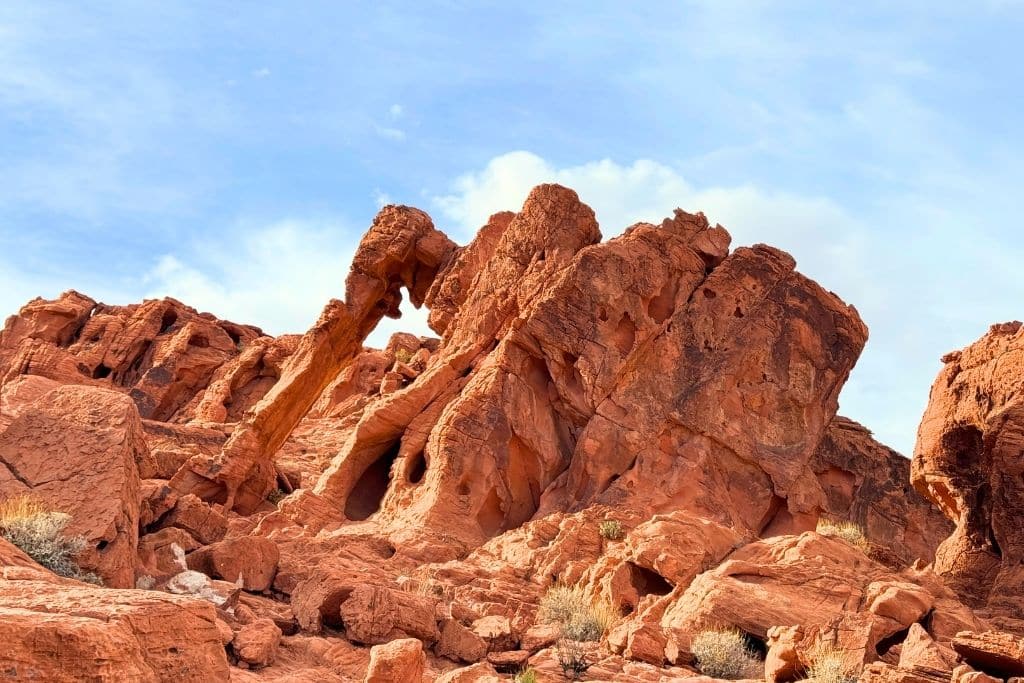
8. See Elephant Rock
Located right at the East entrance of the park, Elephant Rock is a super easy, quick stop that’s worth checking out.
As the name suggests, this unique rock formation looks just like an elephant, complete with a trunk arching toward the ground.
It’s only about a 0.2-mile walk from the parking lot, making it one of the most accessible sights in Valley of Fire. No matter your skill level, you can easily walk up and snap a photo of this fun natural formation!
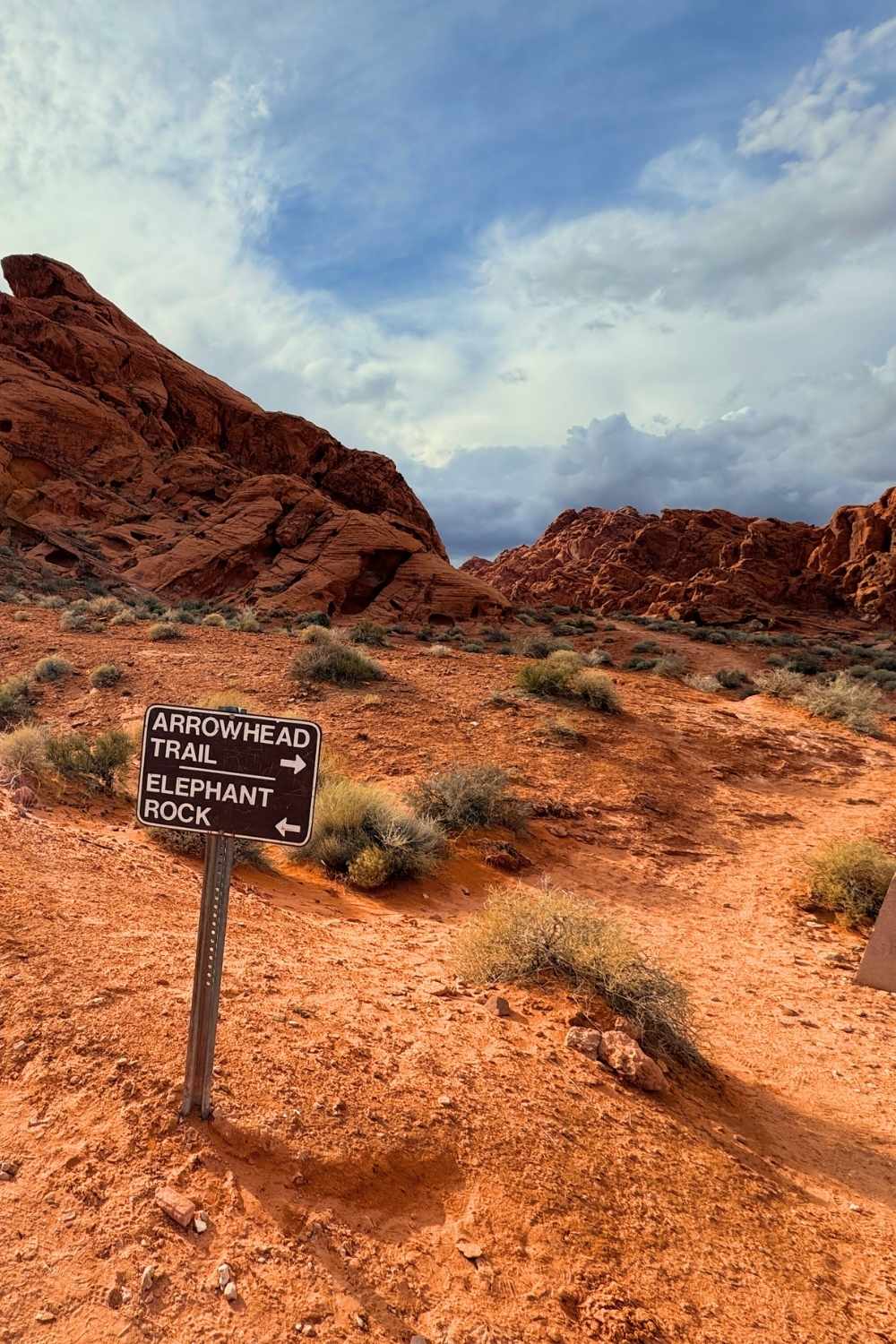
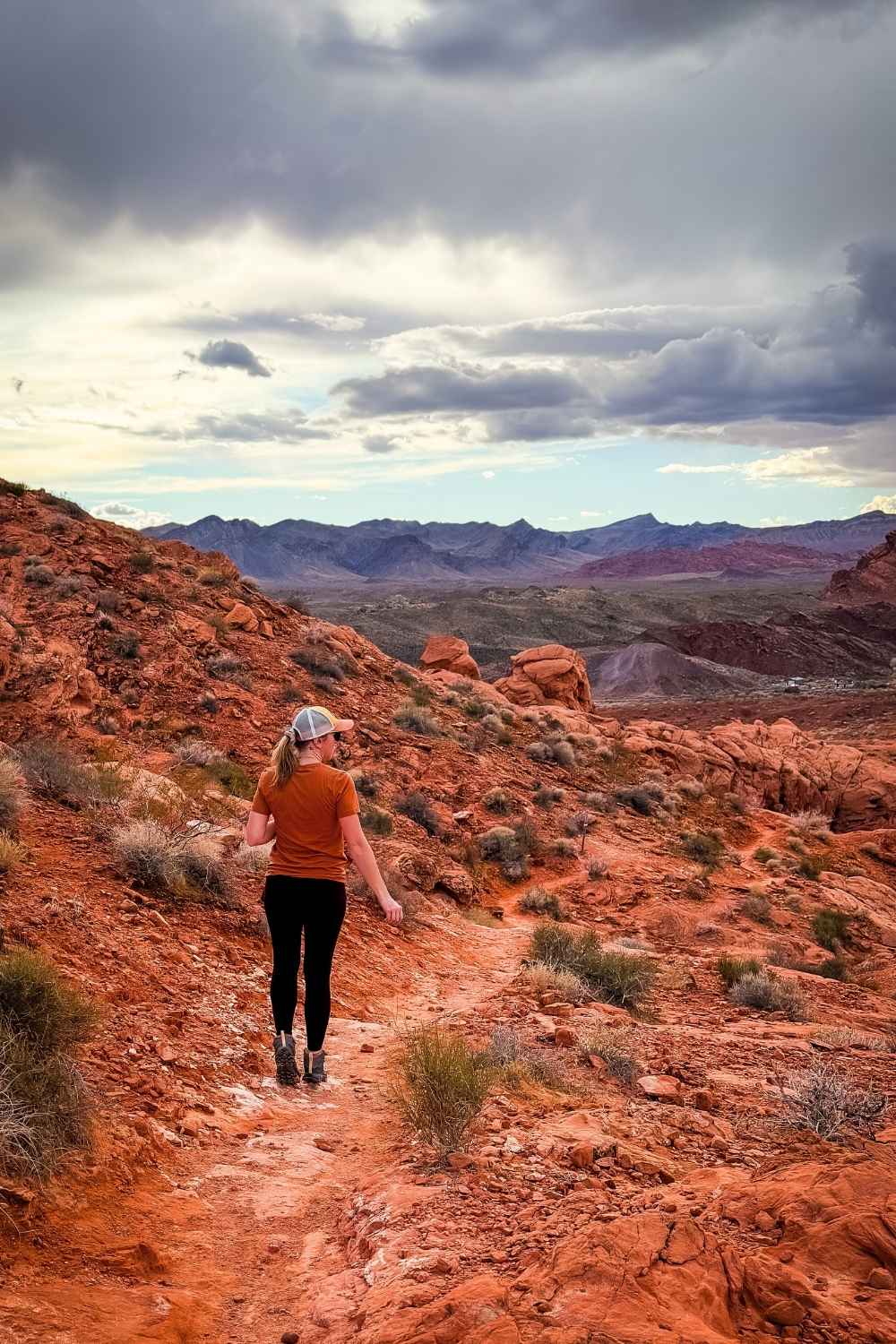
9. Hike Elephant Rock Loop
After snapping a photo of Elephant Rock, don’t just head back to the car—continue onto the full 1.3-mile loop for even more stunning views.
This easy trail follows part of the historic Arrowhead Trail and offers a peaceful walk through the desert landscape.
I hiked it around sunset and had the trail almost to myself, with the evening light and clouds making the scenery even more dramatic. I honestly didn’t expect much from this hike, but it ended up being a great surprise—don’t skip it!
Distance: 1.3 miles Difficulty: Easy Elevation Gain: 173 feet
💡 Pro Tip: I recommend hiking it counterclockwise so you have the valley views out in front of you the whole time, and it’ll pretty much be all downhill, making it more enjoyable.
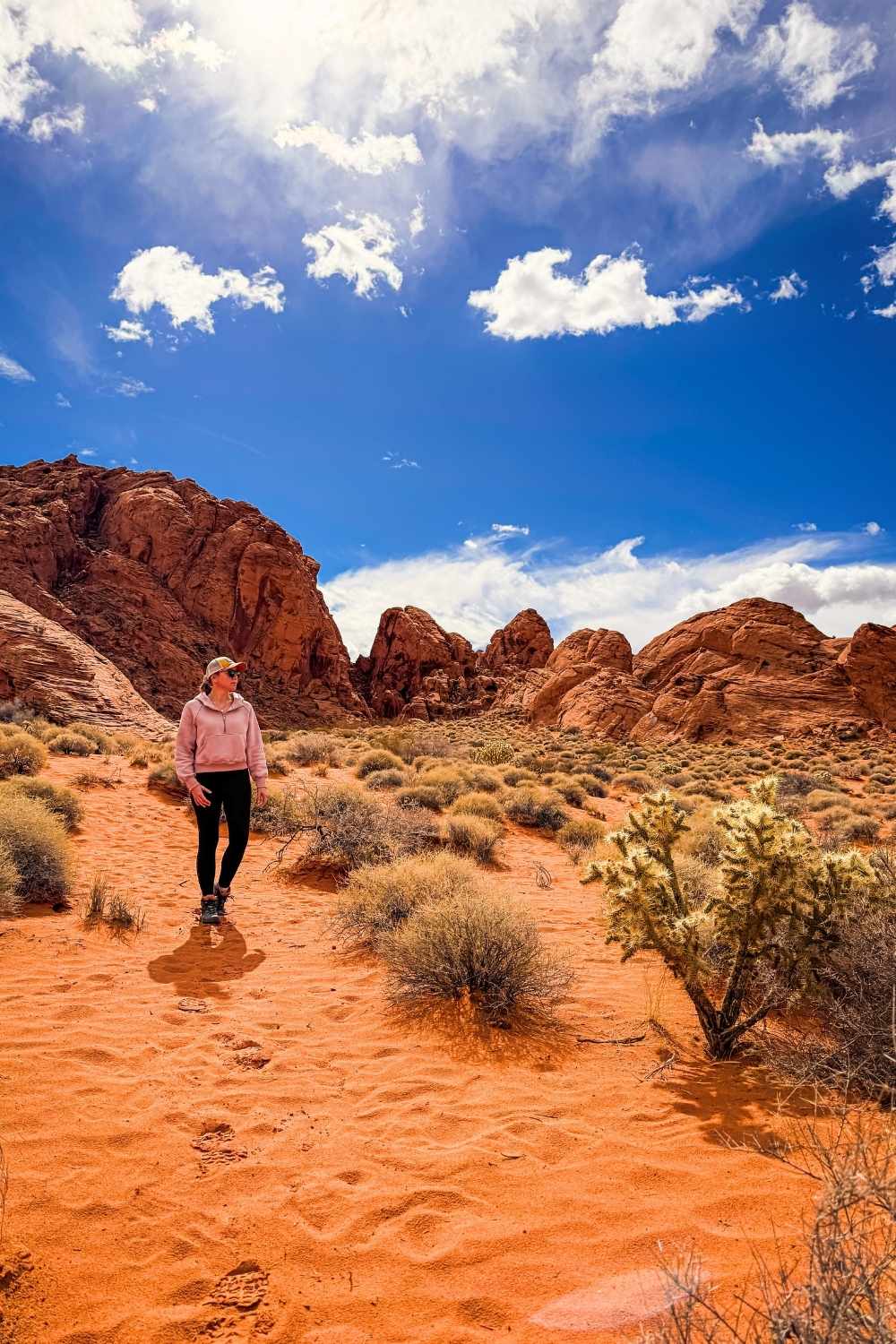

10. Hike Rainbow Vista Trail for the Best View
This was another trail that quickly became one of my favorites in the Valley of Fire.
The steep canyon and rock formations along the way are incredible, and the mountain goats here weren’t shy at all. They practically posed for photos!
But the real highlight is the breathtaking view of Fire Canyon at the end, making this one of the best viewpoints in the park. If you’re looking for a short but rewarding hike, Rainbow Vista is a must!
Distance: 1 mile Difficulty: Easy Elevation Gain: 104 feet
📸 Photo Tip: For the best view and photo spot, climb up the rock formation on the left when you reach the end—it’s 100% worth the extra effort!
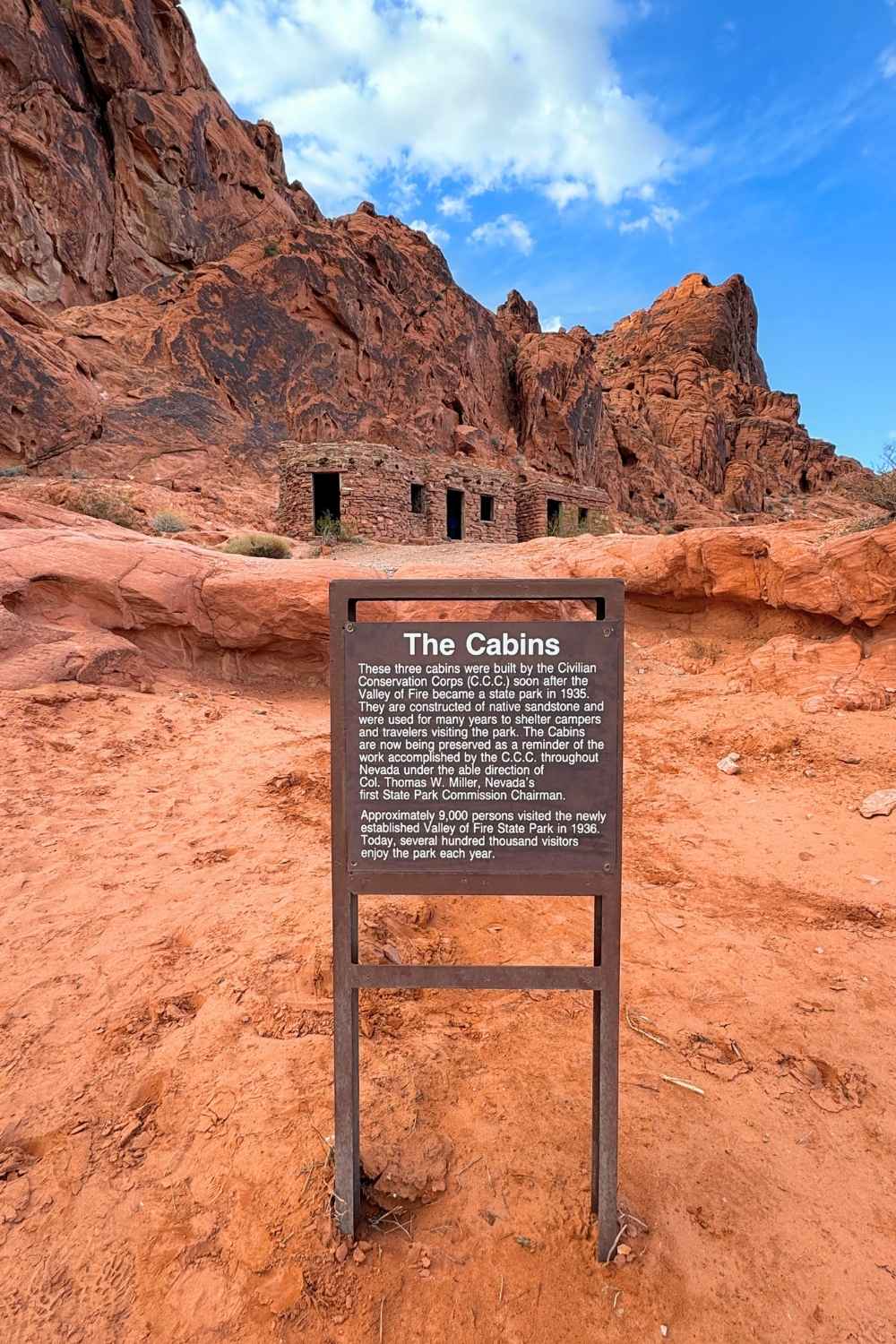
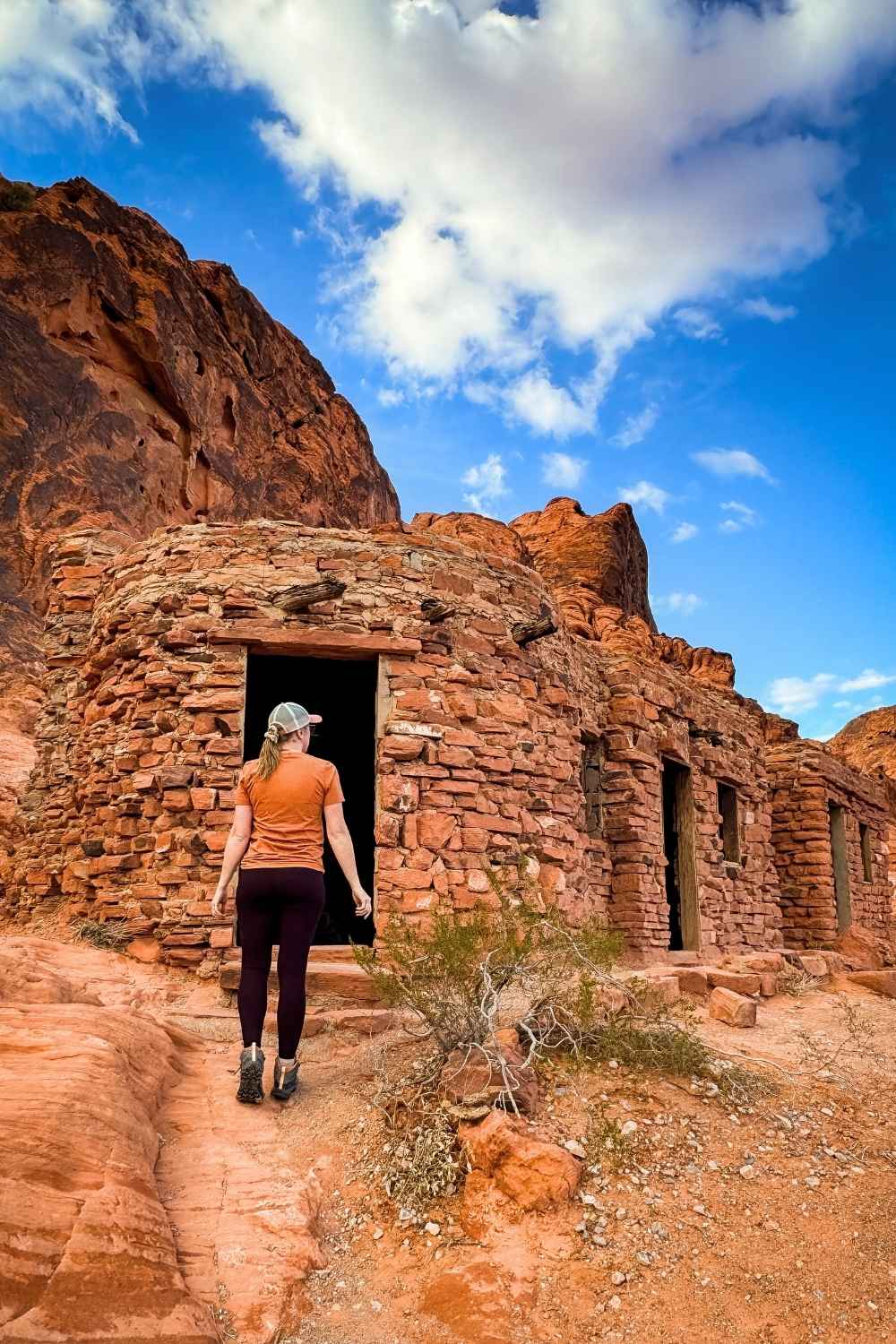
11. Visit The Cabins
I hadn’t originally planned to stop here, but on my way to my campsite, I decided to check out The Cabins—and I’m so glad I did!
These historic stone cabins were built in the 1930s to house early tourists visiting Valley of Fire, and it’s fun to imagine what it must have been like to stay in them back in the day.
The location they chose is absolutely stunning, set against a massive red rock wall that makes for an epic backdrop. If you’re driving by, it’s definitely worth a quick stop!
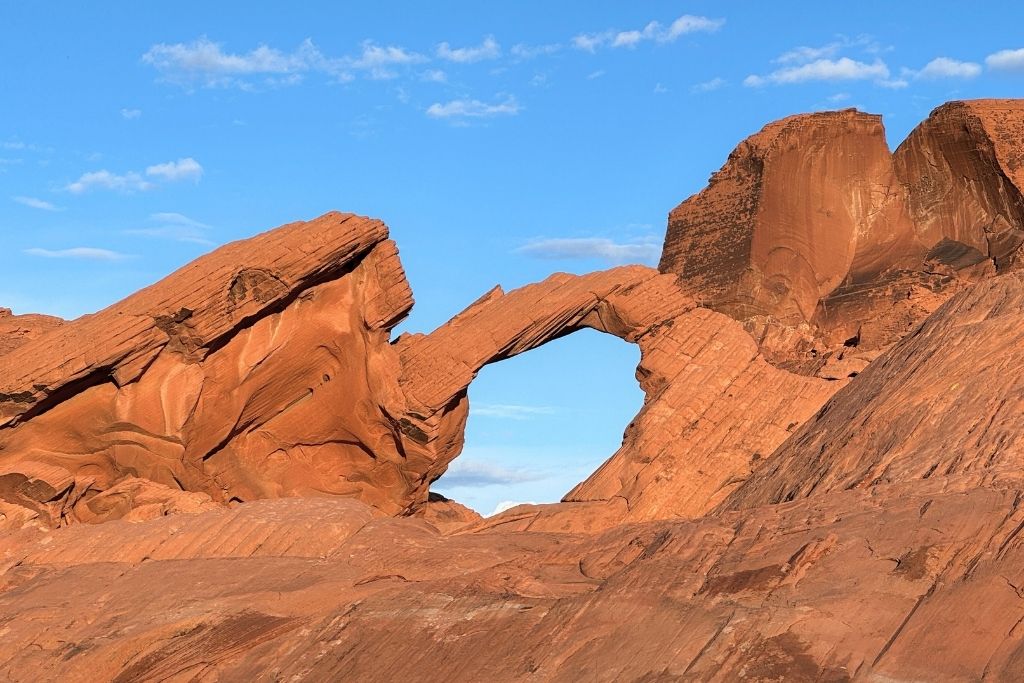
12. See Arch Rock
Arch Rock is a quick and easy stop near the Atlatl Rock Petroglyphs and the campgrounds, making it a convenient sight to check out—especially if you’re camping overnight.
I walked over from my campsite at Arch Rock Campground to see it, and while it’s not the most impressive arch I’ve ever seen, it’s one of the few remaining in the park that hasn’t collapsed.
Considering how fragile these formations are, it’s pretty remarkable that it’s still standing. So, while it may not be the star of the show, it deserves a little respect for beating the odds!
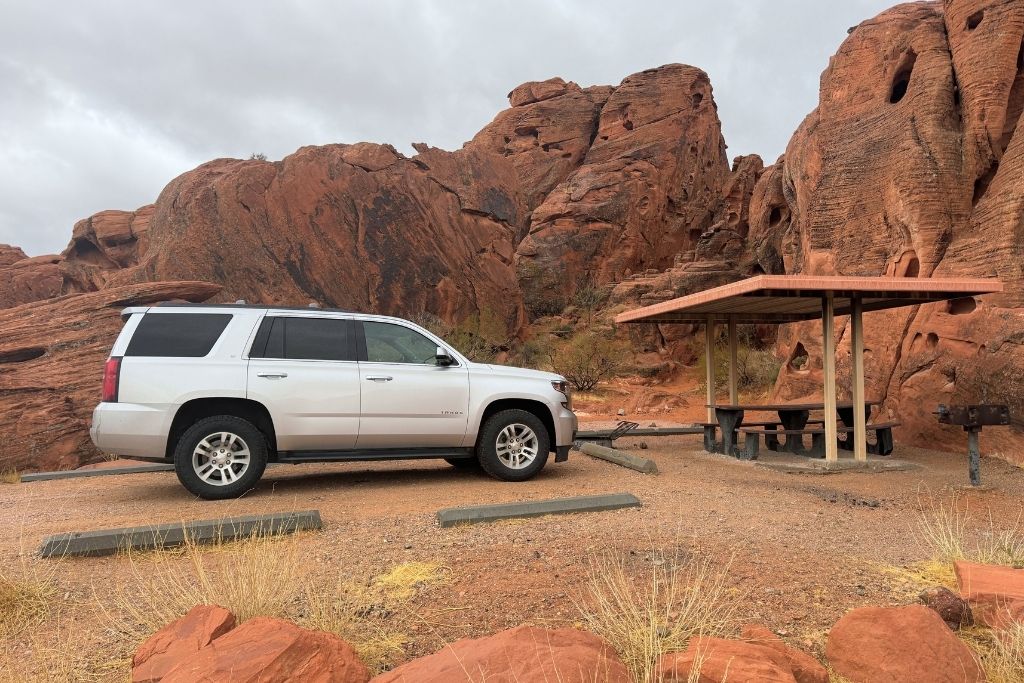
13. Camp Under Red Rock Formations
There’s nothing better than waking up surrounded by towering red rock formations, with the quiet desert all to yourself.
The campgrounds in Valley of Fire are tucked right into the rocks, and some sites feel so secluded it’s like having your own private desert oasis.
I personally prefer Arch Rock Campground over the other, and if you want the best and most private spots, aim for the higher-numbered campsites.
💡 Pro Tip: Camping in the park gives you early access to the best sights before the gates open to day visitors. Since the park closes at sunset for non-campers, you’ll also get to enjoy the park without crowds in the morning and evening—a huge bonus!
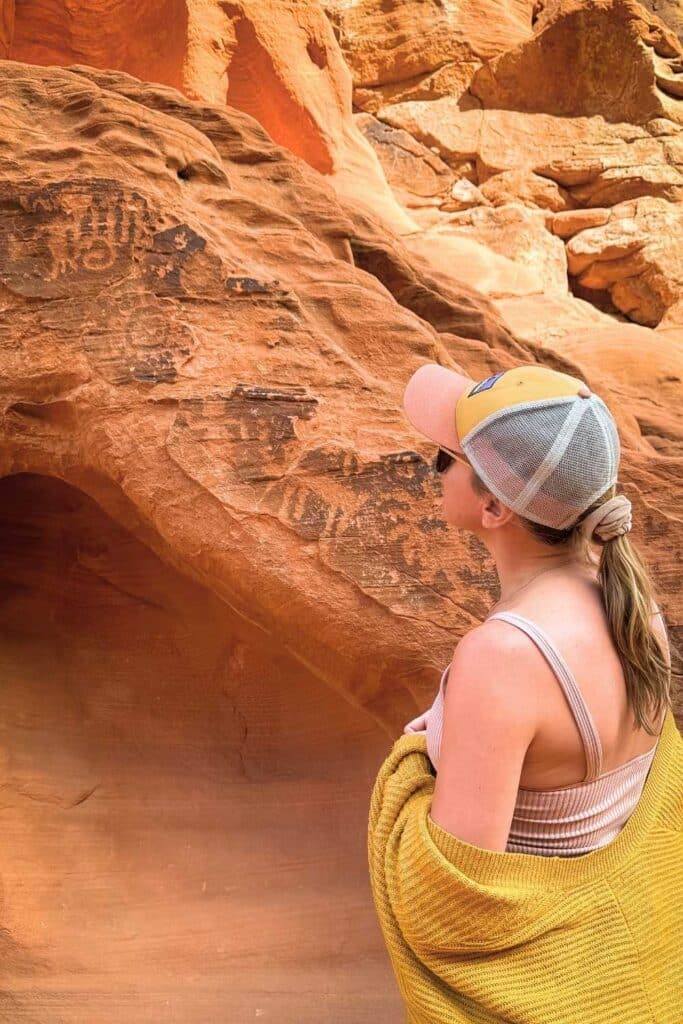

14. Decipher Petroglyphs along Mouse’s Tank Trail
Mouse’s Tank Trail takes you through Petroglyph Canyon, where you’ll find tons of ancient rock carvings scattered along the sandstone walls. Some are thousands of years old, and it’s pretty incredible to see how well they’ve been preserved.
The trail itself is flat, easy, and accessible for all skill levels, making it a great stop for anyone visiting the park.
But if you’re up for a little extra adventure, climb the rock wall at the end of the trail near Mouse’s Tank—there’s an amazing hidden canyon view up there, and since not many people know about it, you’ll likely have it all to yourself. I spent some time just sitting in the silence, taking it all in, and it was one of the most peaceful moments of my trip!
Distance: 0.7 mile Difficulty: Easy Elevation Gain: 49 feet
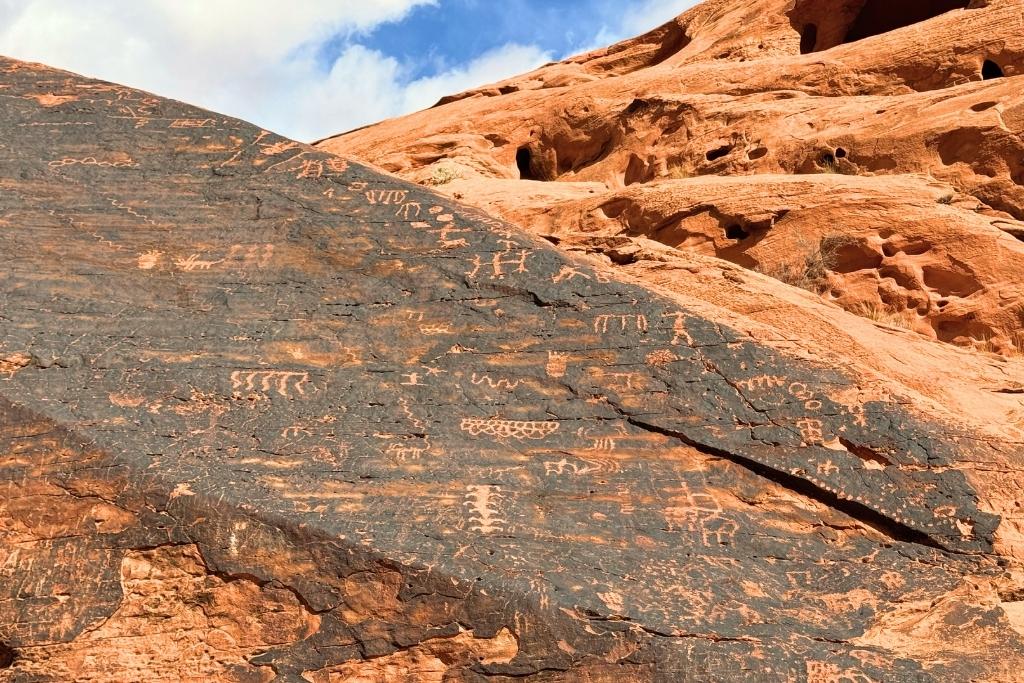
📌 Fun Fact: The black tar coloring on the rocks is called desert varnish, and it forms over thousands of years from a mix of clay, minerals, and bacteria reacting to the desert air. Ancient people used it like nature’s Etch A Sketch, scraping away the dark layer to create the incredible petroglyphs we see today!
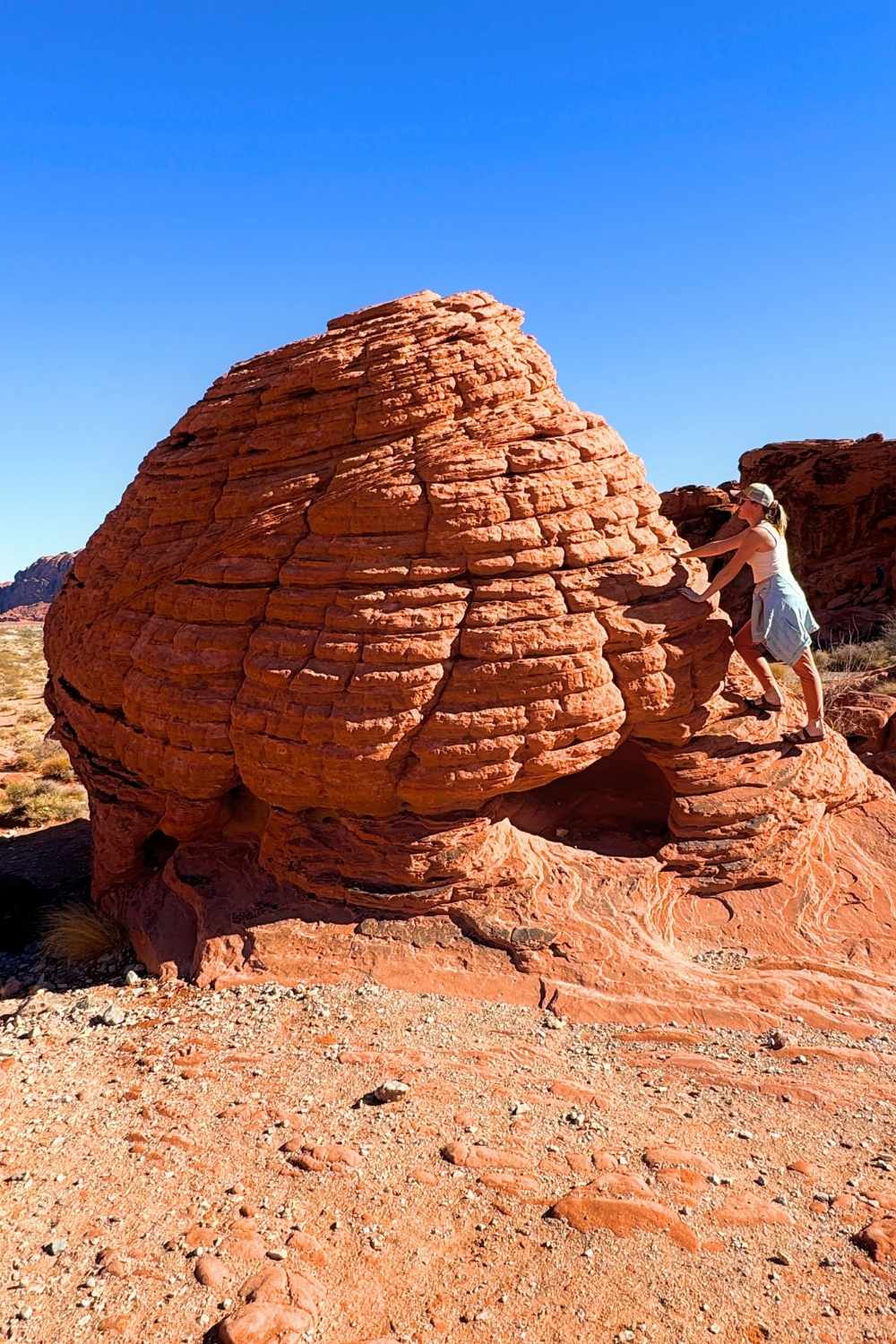
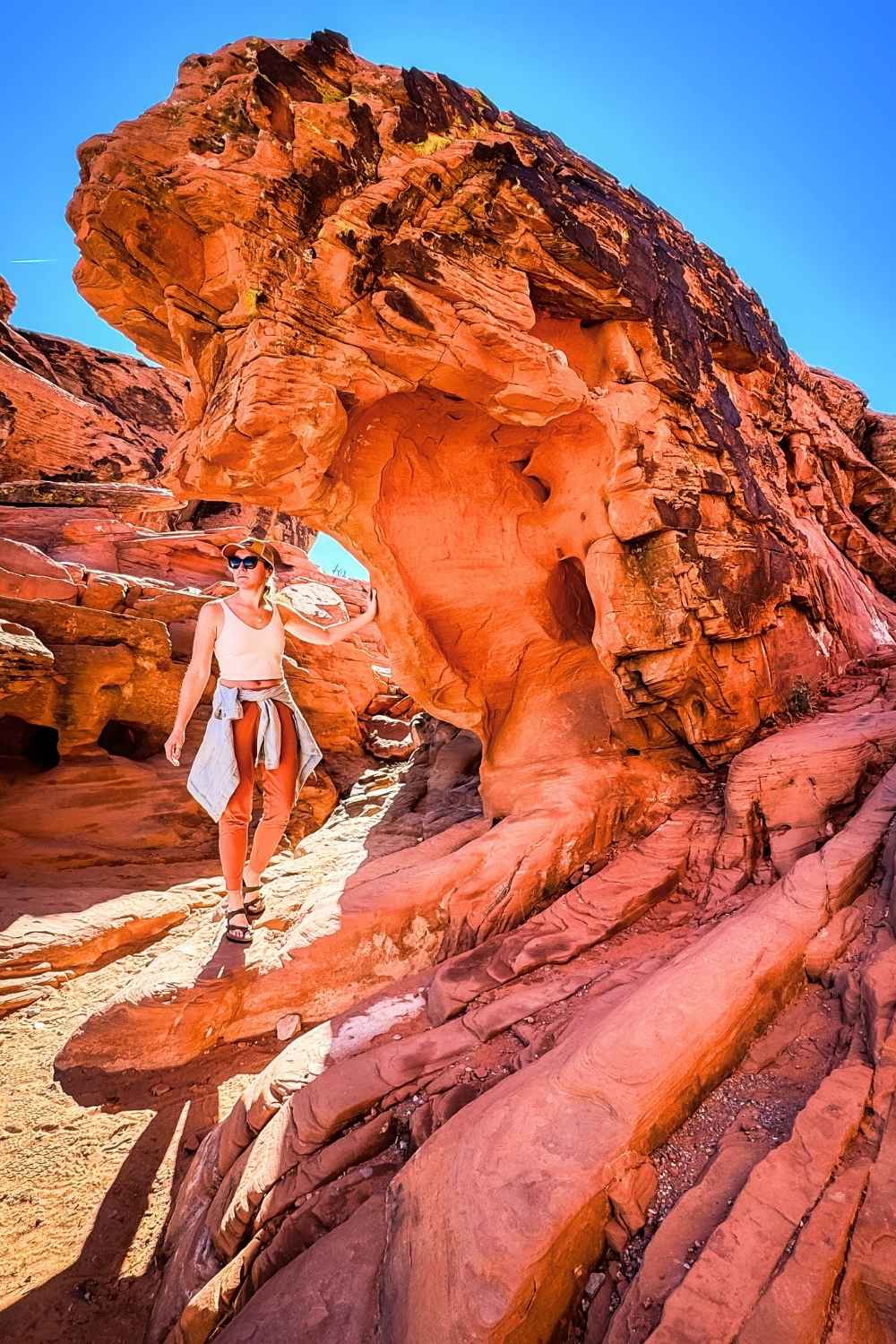
15. Climb the Beehives
Right off the road near the West entrance, the Beehives are a fun and easy stop that you can explore as little or as much as you want.
You can make it a quick visit or spend time climbing the hives for great views or going into the caves, squeezing through holes, and checking out the unique rock formations up close.
These sandstone mounds have a distinct layered look, making them super photogenic and great for capturing fun shots. I had a blast climbing around and snapping photos, so don’t be afraid to channel your inner kid and explore!
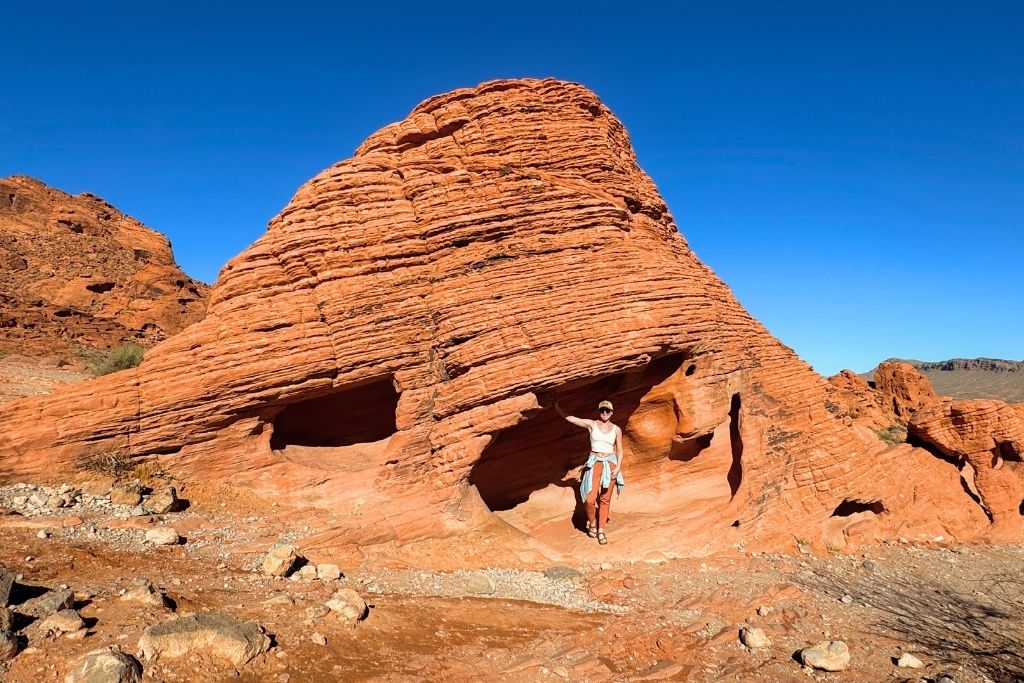
How to Get to The Valley of Fire
The closest major airport to Valley of Fire is Harry Reid International Airport (LAS) in Las Vegas, which is just an hour’s drive from the park.
From Vegas, it’s an easy 50-mile drive northeast via I-15 and Valley of Fire Highway—perfect for a quick day trip or weekend getaway.
Valley of Fire has two entrances: the West Entrance off Valley of Fire Highway, which most visitors use, and the East Entrance, which connects to Lake Mead National Recreation Area.
If you’re road-tripping through Southern Nevada or Utah, you can drive straight through the park and continue on to destinations like Zion National Park, Bryce Canyon, or the Grand Canyon!
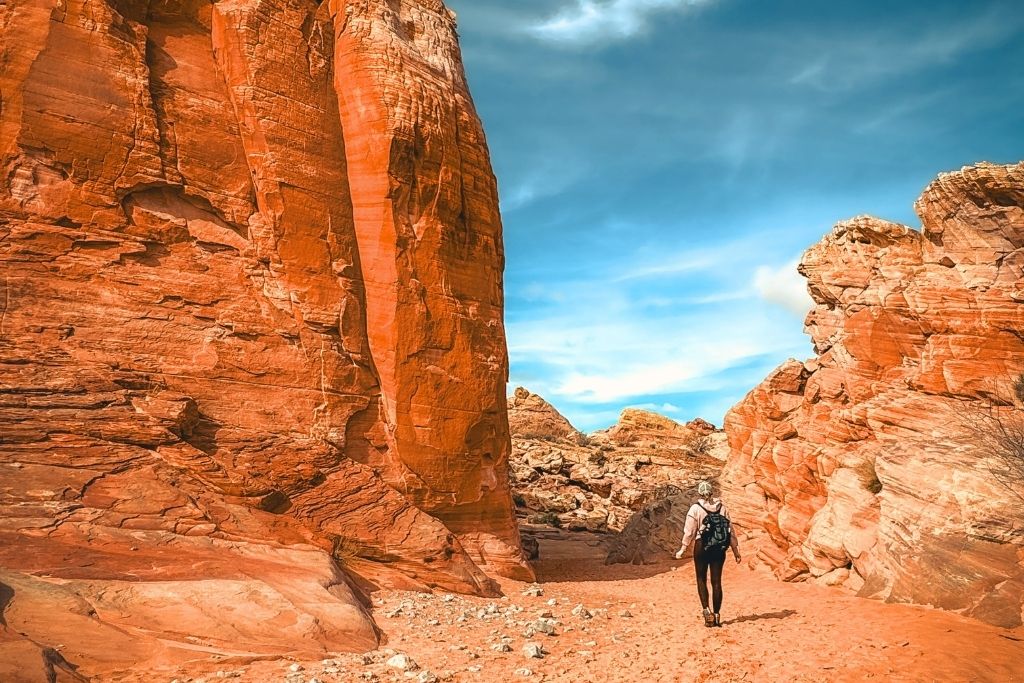
Best Time to Visit The Park
The best time to visit Valley of Fire is spring (March–May) and fall (September–November) when the weather is perfect for hiking and all trails are open.
Summers here are brutally hot, with temps soaring over 100°F, and because of that, many trails close from May to October for safety.
Spring is gorgeous, but keep in mind it comes with the risk of flash flooding, so always check the forecast before heading out.
If you want great weather and fewer crowds, late fall is another solid choice!
📌 Key Point: I went at the end of February, and honestly, it was perfect—cool enough for hiking, warm enough at night for camping, and best of all, I had a lot of the trails to myself.
How Many Days Do You Need in The Park
You can easily see all the best highlights in one full day, but if you want to maximize your experience, I highly recommend camping at least one night.
Waking up inside the park gives you a full 24 hours to explore, plus early access to the most popular spots before the crowds roll in.
If you’re not camping and plan on driving in and out, two days is ideal so you can take your time and not feel rushed.
Either way, Valley of Fire is totally doable as a quick day trip, but an overnight stay makes it even better!
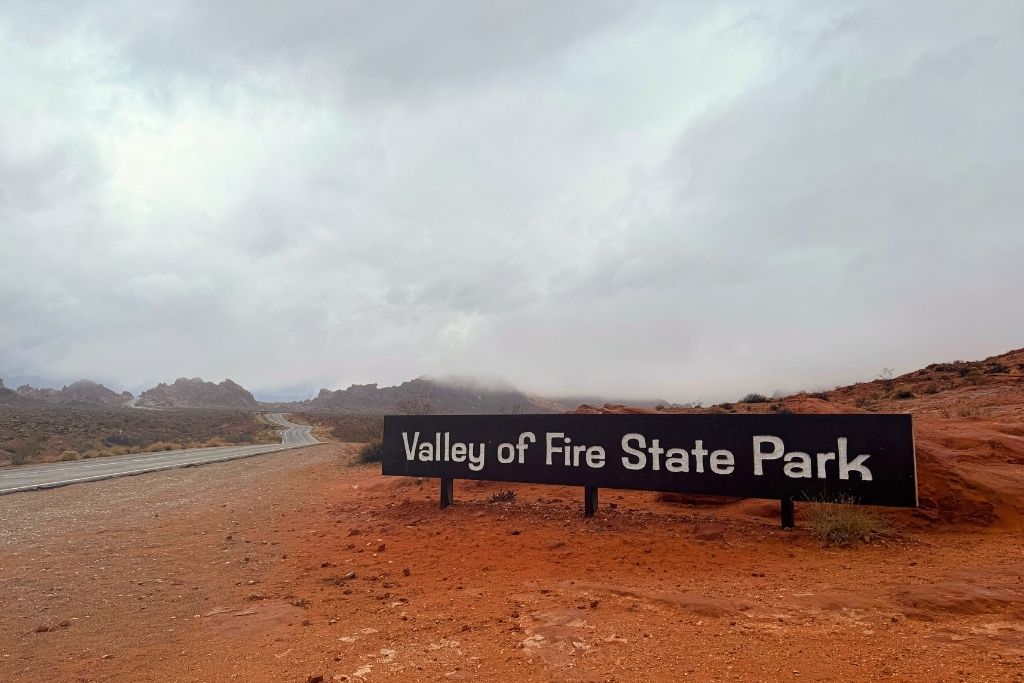
Where to Stay
Whether you’re up for camping under the red rocks or prefer a hotel with modern comforts, there are plenty of options for staying near Valley of Fire.
The park has two campgrounds that put you right in the middle of the scenery, plus a free camping area nearby for those who want a free spot to park overnight.
If camping isn’t your thing, the closest hotels are in Overton, Henderson, and the outskirts of Las Vegas, offering everything from budget-friendly stays to full-on resort experiences.
Valley of Fire Campgrounds
Valley of Fire has two campgrounds with 72 sites, and with the park’s rising popularity, it’s best to reserve a spot in advance on the Reserve Nevada website.
⛺ Arch Rock Campground: My top pick! The sites are tucked into the red rocks for a more secluded, scenic stay. For the most privacy, go for higher-numbered sites.
🚐 Atlatl Rock Campground: Best for RVs, with hookups and showers. The sites are spacious but not as nestled into the rocks as Arch Rock.
📌 Both campgrounds have picnic tables, water, fire pits, and a dump station, so you’ll have everything you need for a great stay.
Free Camping Near Valley of Fire
If you’re looking for free camping, there’s a great BLM dispersed camping area just 10 minutes outside the park near Overton, NV. It’s right off the main road, easy to access, and has level ground with scenic desert views. Plus, unlike inside the park, you’ll have cell service, which is a bonus!
📍 BLM Dispersed Camping near Overton, Nevada
Coordinates: 36.44394235 N, 114.67516382 W
Best Hotels Near Valley of Fire
If camping isn’t your thing, the closest hotel options are in Overton, Henderson, or the outskirts of Las Vegas, all within easy driving distance of the park.
Here are the three best choices that are close:
🏨 North Shore Inn at Lake Mead – Just 9 miles from Valley of Fire, this is the closest hotel to the park. It’s an affordable, no-fuss option with easy access—perfect if you want to get there early and beat the crowds.
🏨 The Westin Lake Las Vegas Resort & Spa – Located 31 miles away in Henderson, NV, this hotel is ideal if you want to relax after a long day of hiking. It even has a spa to help you unwind! Bonus: It’s pet-friendly, which is great if you travel with your furry friend like I do.
🏨 La Quinta Inn & Suites by Wyndham Las Vegas Nellis – 33 miles from the park in Nellis, NV, this hotel is a solid choice if you want to avoid Las Vegas traffic. I’ve stayed at many La Quinta’s before, and they’re always reliable and comfortable. Plus, this one has a pool and is pet-friendly, making it a great spot to cool off after a hot day on the trails.
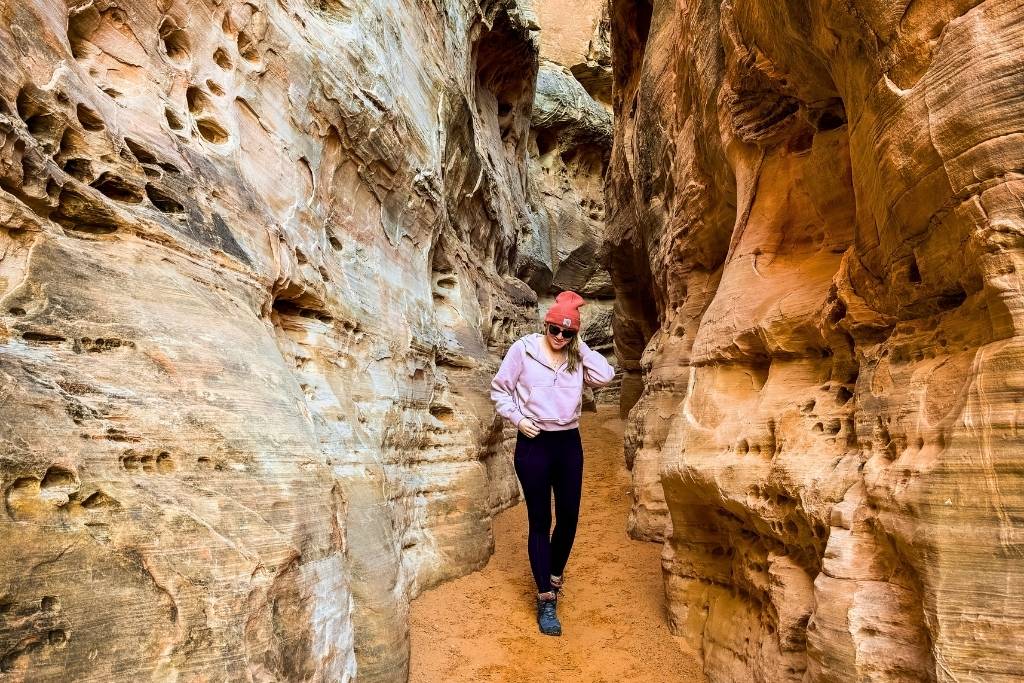
Other Things To Know Before You Go
Before you head to Valley of Fire, there are a few things you’ll want to know to make your trip easier. From entry fees and pet rules to trail closures and cell service, here’s the stuff I wish I knew before my first visit!
Entry:
Valley of Fire is only open from sunrise to sunset, and if you don’t have a camping reservation, you’ll need to leave before the gates close.
National Park Passes are not accepted, so be ready to pay the entrance fee of $10 per vehicle for Nevada residents and $15 for non-residents.
💡 Pro Tip: Stop by the Visitor Center to grab a map or snap a photo of the trail system because not all trails are listed in the park brochure they hand you at the entrance! Hidden gems like the Natural Arch Trail, Pinnacles Loop, and Prospect Trail aren’t marked on the standard map, so getting extra trail info here is worth it.
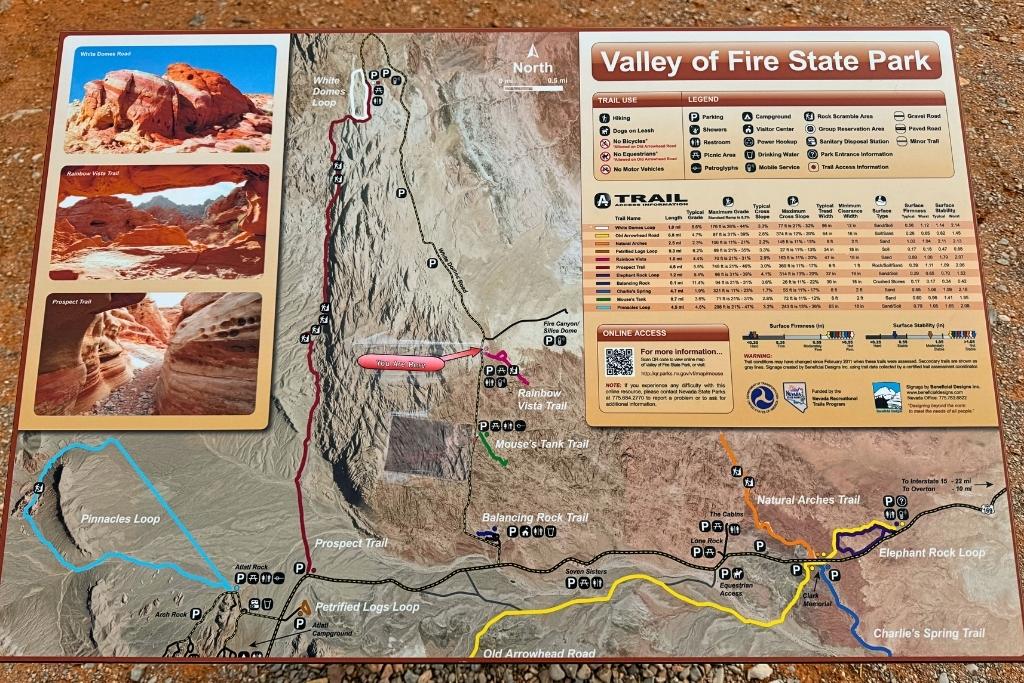
Pets
You can bring your fur kid along for the adventure since dogs are allowed in the park and on all trails, but they must be on a leash at all times.
Keep in mind that the sand and rocks get extremely hot, especially during the middle of the day. If you are bringing your dog, it is best to hike in the early morning or late evening to avoid burned paws.
Annual Trail Closures
Several Valley of Fire trails close between May and October because of the intense desert heat. With temperatures often exceeding 100°F, hiking during this time can be extremely dangerous. These closures are meant to keep visitors safe, so if you are visiting in the summer, be sure to check which trails are open ahead of time.
Cell Service
Cell service is almost nonexistent in Valley of Fire, except for some signal at the East and West entrances. I’ve heard Fire Canyon Overlook has spotty reception, but I couldn’t get any. Download maps in advance or grab one at the Visitor Center just in case.
Appropriate Footwear
I watched people try to hike even the easiest trails in flip-flops, and it did not go well. The fine sand on the rocks is super slippery, and I even saw someone snap a sandal strap and have to walk out barefoot. On top of that, the sand dunes get scorching hot, especially in the summer, and can burn your feet. Do yourself a favor and wear proper hiking shoes!
📌 Love it? Pin it!
That’s a Wrap
And there you have it—15 unforgettable things to do in Valley of Fire!
Whether you’re hiking slot canyons, chasing epic views, or just soaking in the otherworldly landscapes, this park is definitely worth the trip.
Before you go, book your campsite or hotel EARLY, download maps ahead of time, and pack the right gear (seriously, wear good shoes).
Catch ya later

